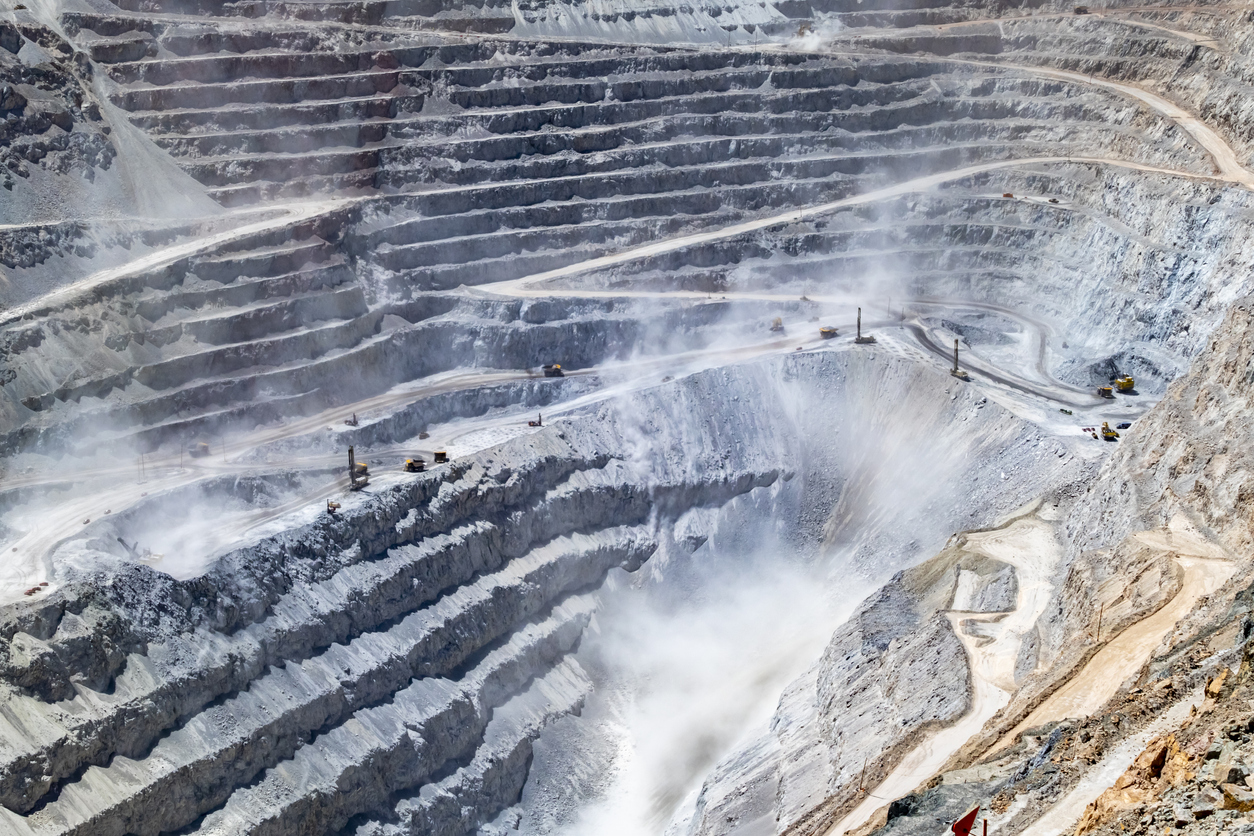
According to Patricio Vergara, Codelco’s vice president of mining resources and development, the mining firm is looking to privatize some of its properties in order to offer non-core exploration assets to the market.
Patricio Vergara believes that such assets could be future partnerships.
Vergara said: ¨We could make some kind of association with those companies that are interested in investing in joint development”, during a presentation at the World Copper Conference.
JV Projects Could Lower Drilling Costs
Given that lithium mining initiatives have been progressing more slowly than previously anticipated, Codelco has been planning to begin lithium exploration in March in the Maricunga salt flat in Chile, which is said to be the second-largest lithium producer in the world.
Vergara added: “We’ve seen permitting, approval times have been a little bit longer than we thought. There have been higher drilling costs.”
Exploration in the Maricunga salt flat in Chile’s Atacama region will be carried out over a period of ten months.
Meanwhile, Codelco has awarded a $27.4 million contract to engineering group Sandvik Mining and Rock Solutions to deliver the Auto Mine loading and haulage automation system for Chile’s El Teniente mine.
The Auto Mine System
Sandvik Mining and Rock Solutions were chosen to deliver its system to Codelco in February 2021. Sandvik’s Auto Mine system is a highly advanced automation system designed to autonomously and remotely operate different types of loaders and trucks.
Auto Mine has the capacity to support up to 32 machines and hardware for its production area and for supplying future expansions. Codelco will be receiving additional trucks and loading equipment to be added to the Auto Mine system from 2023 to 2027.
Sandvik Mining and Rock Solutions business area president Henrik Ager said: “I am pleased to see a continued strong interest for AutoMine solutions that contribute to improving safety, reliability and productivity in the mine and I look forward to the partnership with Codelco in this project.”
In turn, Sandvik Mining and Rock Solutions secured an order for loading and haulage equipment from Codelco. The contract initially valued at US$16.4 million will have an extension from 2022 to 2027.
The contract stipulates that Sandvik will also supply equipment such as Toro TH663i trucks and Sandvik LH514 loaders to Codelco through this year and 2023. Sandvik acquired DSI Underground last year for US$1.15 billion, which offers ground support and reinforcement products for the mining and tunnelling industries.
The above references an opinion and is for information purposes only. It is not intended to be investment advice. Seek a licensed professional for investment advice. The author is not an insider or shareholder of any of the companies mentioned above.

As global investor confidence continues to wane contributing to volatility in the equities markets, commodities are running their own course –supply concerns are pushing oil prices to their highest levels in over a decade while the precious metals sector characteristically responding to geopolitical uncertainty has driven up gold and silver prices dramatically.
And whereas strengthening gold and silver prices would be expected to boost senior mining firms’ profits, inevitably one would expect this to trickle down to the juniors in the form of M&A, JVs and equity investments. For that very reason, it may well be the perfect time for investors to add some gold equities and particularly junior golds to their portfolios. Let’s consider three Canadian gold stocks that may be worth a closer look.
Trillium Gold Mines (TSXV:TGM) (OTC:TGLDF), a Canadian gold exploration company, has amassed one of the greatest land packages in and around the Red Lake mining district, adjacent to major mines and deposits, as well as over 100 kms along the highly prospective Confederation Lake greenstone belt. The company is currently trading at a fraction of its 2-year high despite the quantifiable advancement of its projects.
Trillium recently reported results from surface channel sampling and mapping at its Rivard property, located near the world-class Red Lake Operations, which has shown huge high-grade potential. Rivard is located adjacent to Trillium’s 100%-owned Newman Todd complex.
The Rivard Property has historically contained significant alteration and widespread gold mineralization in narrow high-grade veins in outcrops and trenches. This 90-hectare tract of land is immediately adjacent to Newman Todd and hosts oxidized quartz veins ranging up to 561 g/t that was mined by the Rivard family for over two decades. The company is currently drilling and advancing the Newman Todd to an open-pit mining scenario. Another property that holds tremendous promise is the 80%-owned Gold Centre located within a mere 350 metres from the world-famous Campbell-Red Lake Mine where Trillium is currently drilling to prove that Gold Centre is the extension of that prolific mine.
Centerra Gold (TSX:CG)(NYSE:CGAU) is a Toronto-based gold mining company with a market capitalization of about $3.8 billion. Its Mount Milligan mine in British Columbia accounted for almost 56% of its total revenue in 2021. The remainder of Centerra’s income for the year came from other operations.
Last year, the firm experienced several difficulties following Kyrgyzstan’s seizure of control of its Kumtor Gold Mine. This is one of the major reasons its revenues have dropped by almost 47% year over year to around $900 million in 2021. However, the company is currently engaged in discussions and negotiations with Kyrgyzstan’s government to help resolve the disputes as quickly as possible.
SSR Mining (TSX:SSRM) (NASDAQ:SSRM) is the last gold stock on the list that might be worth checking out. Last year’s revenue bump by nearly 73% last year to about US$1.5 billion was a big driver of its success.
SSR Mining’s strong revenue and production growth helped it post a solid 88.5% increase in adjusted net profits from the previous year, to about US$402 million. Its adjusted net profit margin also improved significantly in 2021, increasing to around 27.3 percent from 25 percent in the prior year.
A Banner Year Ahead
Despite the abundant geopolitical risks and challenges the global markets are facing, precious metals demand has been skyrocketing. This has caused prices for gold and silver to surge, which bodes well for companies in the precious metals mining industry.
That said, Trillium Gold Mines, Centerra Gold, and SSR Mining may be worth considering as potential additions to your portfolio right now. All three stocks have reported encouraging results recently and continue to look to a future full of prospective discoveries, higher revenues, and profits.
The above references an opinion and is for information purposes only. It is not intended to be investment advice. Seek a licensed professional for investment advice. The author is not an insider or shareholder of any of the companies mentioned above.
Collective Mining (TSXV:CNL) announced this morning the completion of an Induced Polarization, ground geophysical survey on part of its San Antonio project located in Caldas, Colombia. The survey area covered 2.75 square kilometres and encompasses the previously defined, priority targets named Pound and Dollar. The Company previously announced that it had made a significant grassroot drilling discovery at Pound target as part of its Phase I program at San Antonio.
Ari Sussman, Executive Chairman of Collective Mining, commented: “The IP survey in San Antonio clearly outlines exciting targets for follow up drilling. At the Pound target, there is now a clear opportunity to expand the wide and continuous zones of mineralization previously intersected from surface with further drilling into the mineralized schist and along northern extensions to the breccia. At the Dollar target, our previous drilling only clipped the edge of the highly chargeable western anomaly and internal modelling of grade shells from drilling are pointing directly to the untested eastern anomaly. Drill planning is already underway for a follow up program to begin in the second half of 2022.”
Figure 1: Plan View of the San Antonio Project Highlighting the Pound and Dollar Targets
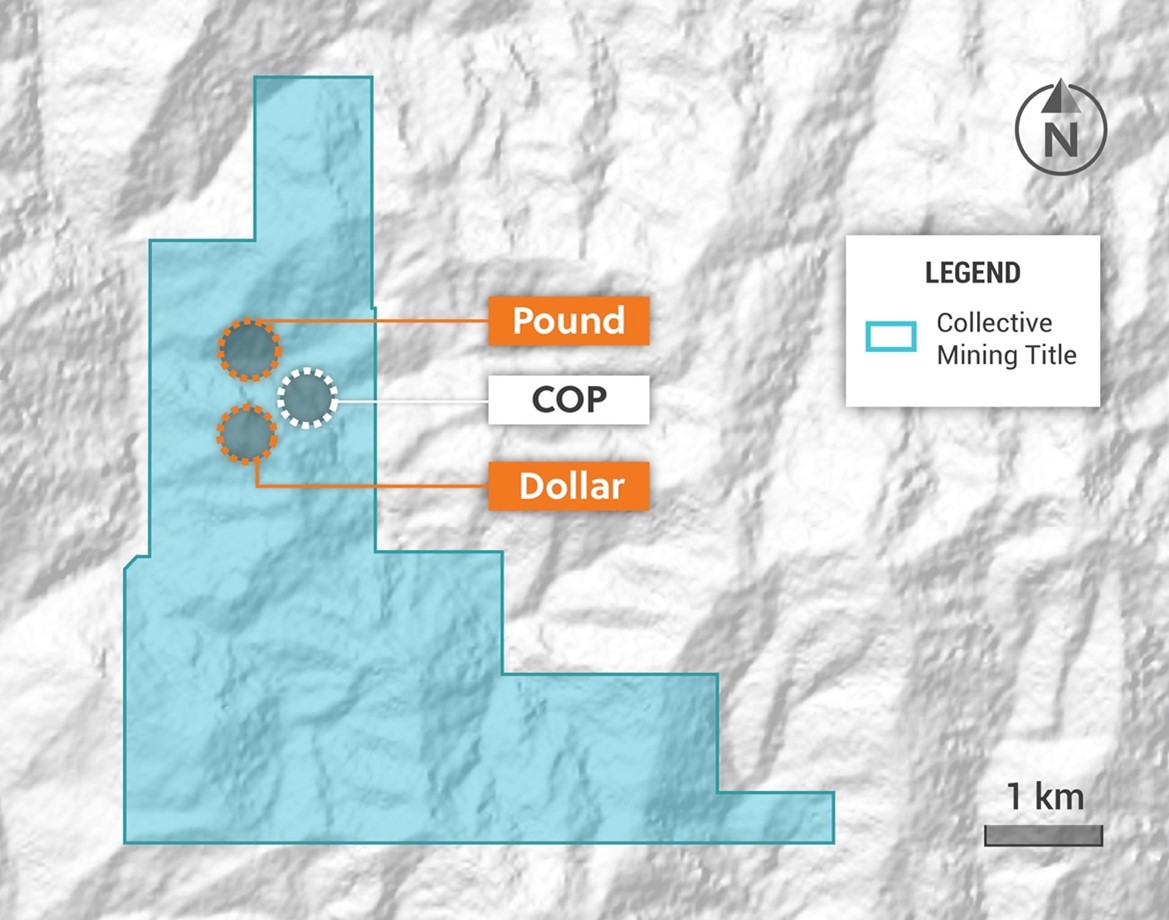
Highlights from the survey include:
- The Pound target is coincident with a circular chargeability anomaly present at shallow depths and covering a diameter of 600 metres. Previous reconnaissance drilling of two holes returned broad, continuous, mineralized intercepts from surface of 710 metres grading 0.53 g/t AuEq (SAC-6) and 750 metres @ 0.41 g/t AuEq (SAC-8). The Pound intercepts relate to mineralization hosted within breccia, porphyry and schist rocks. The IP work clearly demonstrates that the contact zone and the mineralized schist body are open to the north, south and east and can be tested from relatively shallow elevations.
- Importantly, both drill holes into the Pound target ended in mineralization in the schist body with copper and molybdenum grades increasing at depth and including 70 metres at 0.12% copper in SAC-6 and 133 metres @ 0.15% copper in SAC-8.
- The chargeability IP data at Pound also demonstrates potential extensions of the mineralized breccia body to the NNW for at least another 800 metres.
- IP data at the Dollar target highlights chargeability anomalies directly to the west and east of the area previously drill tested in the Phase I campaign.
- The western anomaly is located approximately 300 metres below surface and covers an area measuring 600 metres across by 500 metres vertical. Previous drilling only clipped the edge of this body in two holes; both of which demonstrate increasingly, porphyry related, potassic alteration within a quartz diorite porphyry near the end of each hole. Peripheral drilling at Dollar previously intersected 74 metres grading 0.62 g/t gold equivalent from a quartz magnetite stockwork in the quartz diorite porphyry.
- The more subtle porphyry shaped eastern anomaly is located approximately 75 metres below surface and measures 250 metres across by 900 metres vertical. No previous drill testing was conducted within this anomaly but modelling of grade shells from prior holes indicate an eastern dip to the highest-grade mineralization towards the anomaly.
- The target extensions at Pound and new targets at Dollar will be followed up with diamond drilling programs during the second half of 2022.
Figure 2: Section View of the Pound Target Outlining a Significant Chargeability Anomaly Directly Contiguous to the Bottom of the Two Prior Discovery Drill Holes
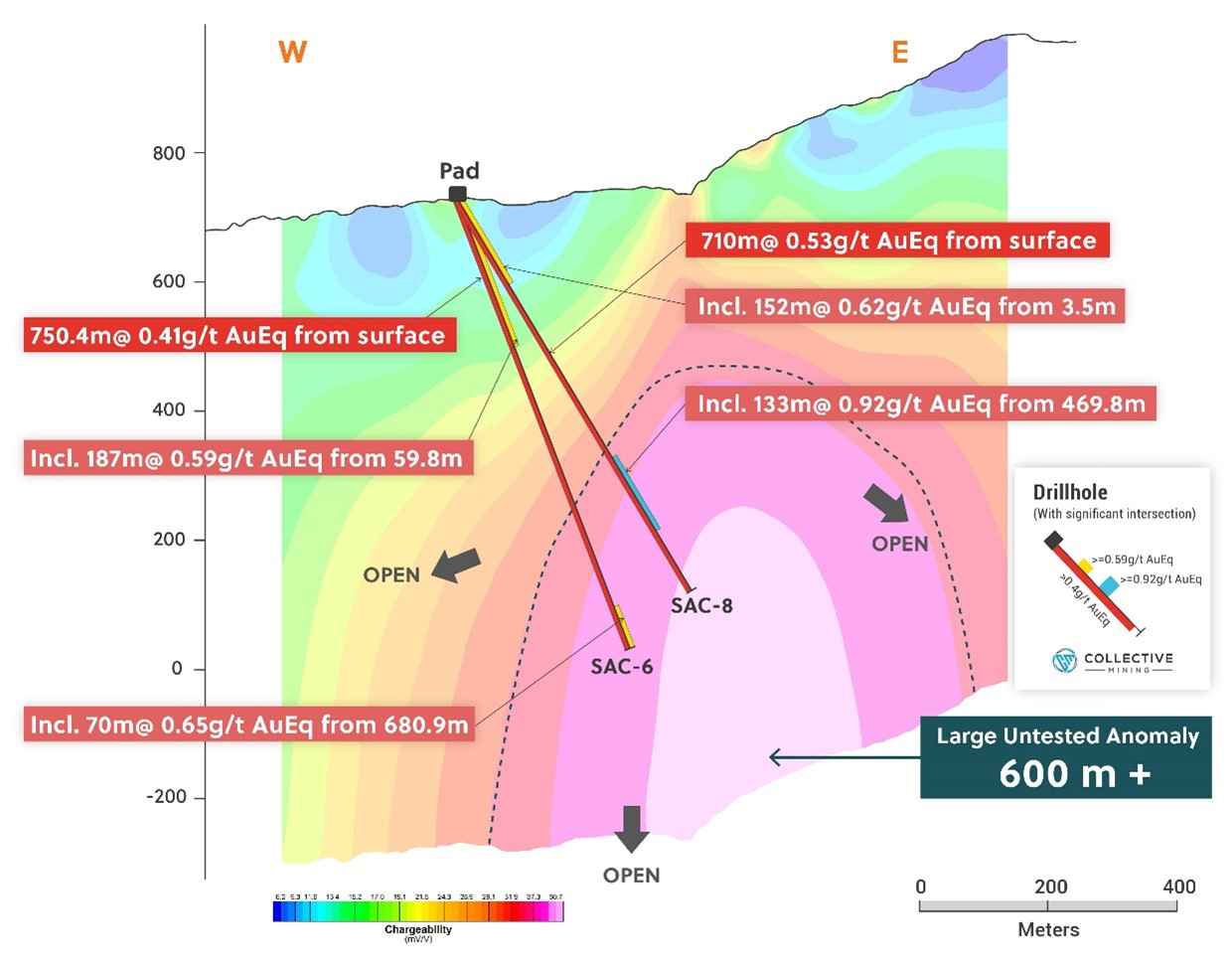
Figure 3: Section View of the Chargeability Anomalies at Dollar. The Western Anomaly Was Clipped at the Top by Prior Drilling While the Eastern Anomaly Has Yet to be Drill Tested
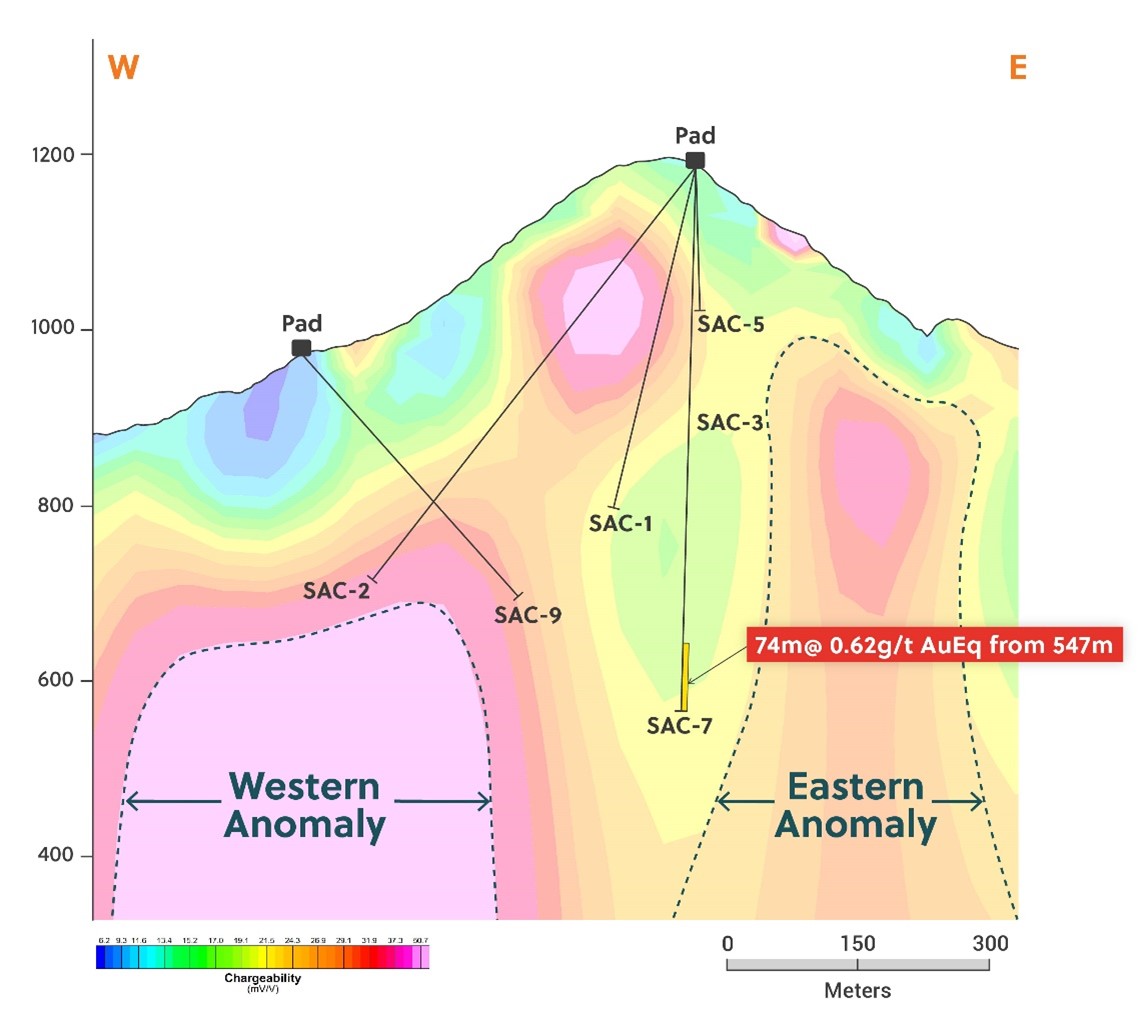
Collective Mining is a South American exploration and development firm specializing in identifying and prospecting for prospective mineral project. The team that developed and sold Continental Gold Inc. to Zijin Mining for approximately $2 billion in enterprise value is leading the Company’s mission to repeat its past success in Colombia by making a significant new mineral discovery and developing the project to production.
The above references an opinion and is for information purposes only. It is not intended to be investment advice. Seek a licensed professional for investment advice. The author is not an insider or shareholder of any of the companies mentioned above.

Nickel prices continue to swing suddenly and have now fallen such that they reached the 15% daily limit on the London Metal Exchange last Thursday. This occurred as the market attempted to recover after a week of trading disruption and unprecedented short position compression.
After reaching a new daily limit introduced by the LME to stabilize the market, prices rose again by 14%. Even when nickel futures reopened on March 16, trading was halted as the metal again plunged to the limit at the open each morning.
In the first days of March, nickel prices climbed 250% during trading in which it reached a record $101,365 per tonne amid a short squeeze centered on China’s Tsingshan Holding Group Co. Despite interventions by the exchange including a week-long suspension and the cancellation of billions of dollars of trades at higher prices, the market fell. Now the market is down 70% from the all-time high and up more than 30% since the beginning of March.
In order to avoid asking for more margins, Tsingshan reached an agreement with the banks. However, there are still downside bets in the market to be eliminated at a time when supply fears are latently on the rise.
Nickel prices are now in line with nickel contracts on the Shanghai futures exchange which had a minor rally during the March turmoil and fell as a commodity sell-off that occurred amid the week-long LME suspension.
Trading in the metal is becoming increasingly difficult to conduct each day so many investors are looking to liquidate their positions due to the metal’s poor market performance.
As China continues to grapple with the spread of Covid-19 in Shanghai, its worst outbreak of the virus in two years, metal trading on the Shanghai futures market has started to calm down and investors are becoming more cautious by the day.
With the resurgence of coronavirus in China, the world’s largest producer and consumer of base metals, the country’s industrial bases have been forced to shut down leading to disruptions in logistics, manufacturing and consumption.
Prices continue to be volatile as markets decide how much the impact of further lockdowns in mainland China, and a surge in cases in Hong Kong could be.
The above references an opinion and is for information purposes only. It is not intended to be investment advice. Seek a licensed professional for investment advice. The author is not an insider or shareholder of any of the companies mentioned above.
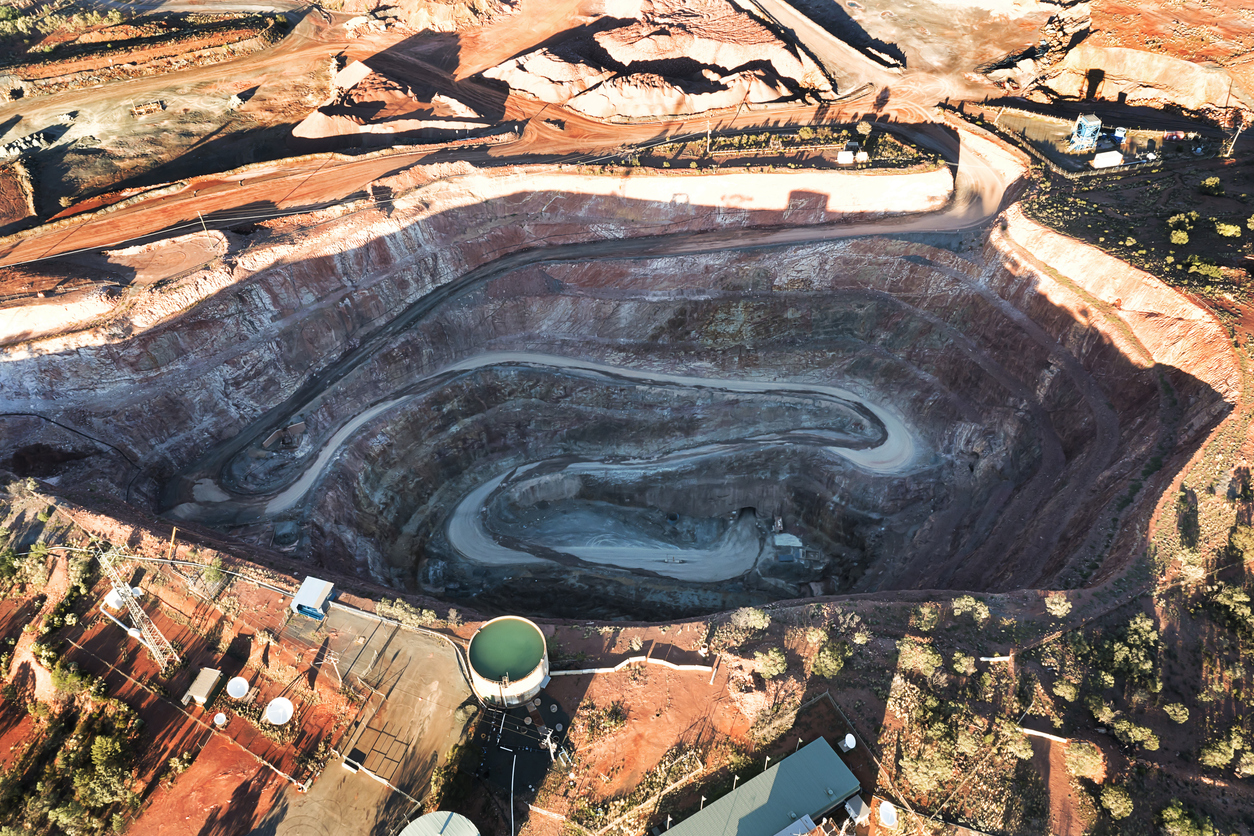
Australia-based mining explorer KGL Resources has signed a participation agreement with Glencore (OTC:GLNCY), the Anglo-Swiss commodity trader for copper concentrate produced at its Jervois copper project.
Under the agreement, which has a minimum term of five years from the commencement of commercial production from the project, Glencore to acquire 100% of copper concentrate produced at the Jervois copper project.
The contract with Glencore, is subject to securing project financing by the end of September 2025 or commencement of commercial production by December 2025 at the latest, among other terms and conditions.
KGL managing director Simon Finnis said: “This agreement is a key component of KGL’s plans to procure funding for the development of Jervois.
“Work is continuing on the feasibility study, which will incorporate the terms of this agreement, as well as the new resource data from the Bellbird, Reward and Rockface deposits. We expect this will result in favourable annual production and mine life outcomes.”
The Jervois project has a total copper resource of 20.97 million tonnes at 2.03% copper and 31.9 g/t silver.
KGL said in a statement: “The sale price for the copper concentrate is volume-based and calculated by reference to the LME cash settlement price for copper, with silver and gold credits (subject to minimum ‘payable’ limits) and adjustments for penalties, treatment and refining charges and a freight credit.”
Production will be delivered to Glencore’s Mount Isa copper smelter located in inland Queensland.
Glencore also recently announced that it reached an agreement with Metal Acquisition Corp for the sale and purchase of the CSA copper mine for which it will receive $1.05 billion in cash.
The above references an opinion and is for information purposes only. It is not intended to be investment advice. Seek a licensed professional for investment advice. The author is not an insider or shareholder of any of the companies mentioned above.
Trillium Gold Mines Inc. (TSXV:TGM) has reported drilling progress on the company’s 80% owned Gold Centre property. Trillium has received six of eight drill results from the 2021, 9,329-metre drill program focused on the north end of the property targeting the Red Lake mine stratigraphy.
Gold Centre consists of 16 contiguous historic mining concessions over 253 hectares and is located just 350 metres from Evolution Mining’s (EVN-RLO) Red Lake operations. The Company believes that the southeast plunging mine trend extends onto its Gold Centre property and may represent the continuation of the world-class mine.
Figure 1: Close-up of visible gold in sheared and altered gabbro associated with arsenopyrite.
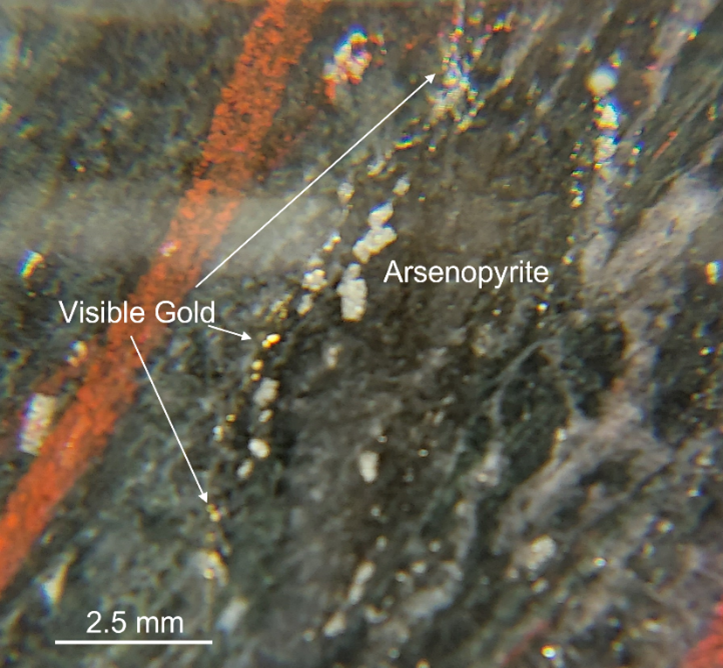
The mineralization encountered to date is estimated to be similar to that found on the adjoining property in terms of rocks, vuggy alteration and mineralization. Results identified visible gold (VG) at 782.2 metres in a shear parallel to the foliation associated with arsenopyrite and hosted in a silica-altered gabbro unit of the Balmer assemblage, the host rock of the Red Lake mine.
William Paterson, Trillium Gold’s Vice President of Exploration commented in a press release: “Proving Gold Centre’s continuity to the EVN-RLO has always hinged on identifying the Balmer host rocks at depth which we have achieved. The results to date have been positive and we are assembling vital evidence that will allow us to focus on the high-grade gold mineralization believed to be present. We have observed all the key components on this property that are analogous to the gold mineralization next door.”
Figure 2: Plan showing holes GC21-01 through GC22-08 at north end of the Gold Centre Property, significant gold values above 0.1 g/t Au and regional magnetics survey.
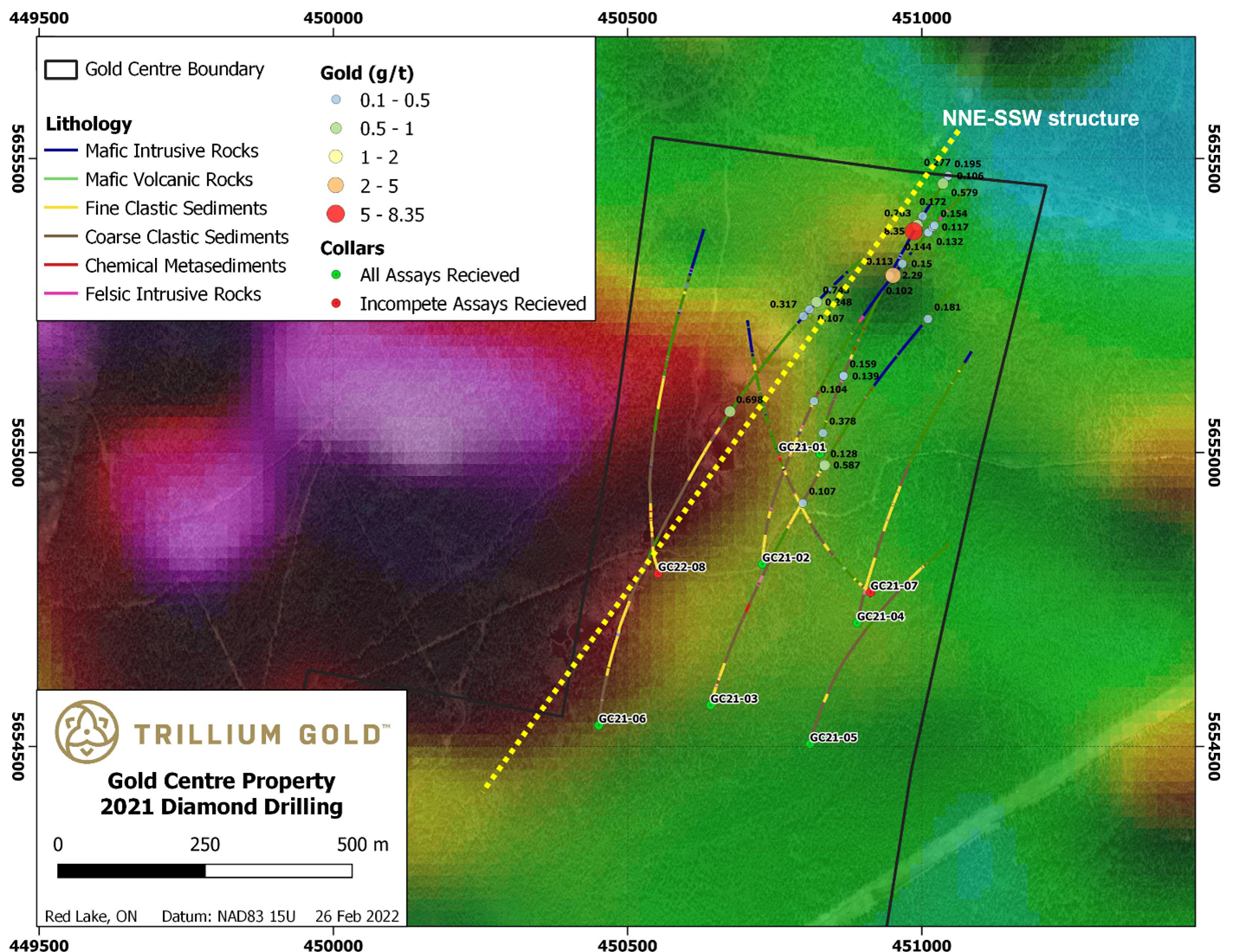
For Trillium Gold, a discovery at Gold Centre would be tantamount to a windfall or lottery. Finding the underground extension of a world-class, high-grade producing mine in a stable jurisdiction such as Red Lake, Ontario is a once in a lifetime situation.
The 2022 drill program will be focused on a fifth gold trend found deeper in adjoining Red Lake. Results have only been received from the first six drill holes due to industry-wide delays in receiving assay results from the labs.
The above references an opinion and is for information purposes only. It is not intended to be investment advice. Seek a licensed professional for investment advice. The author is not an insider or shareholder of any of the companies mentioned above.
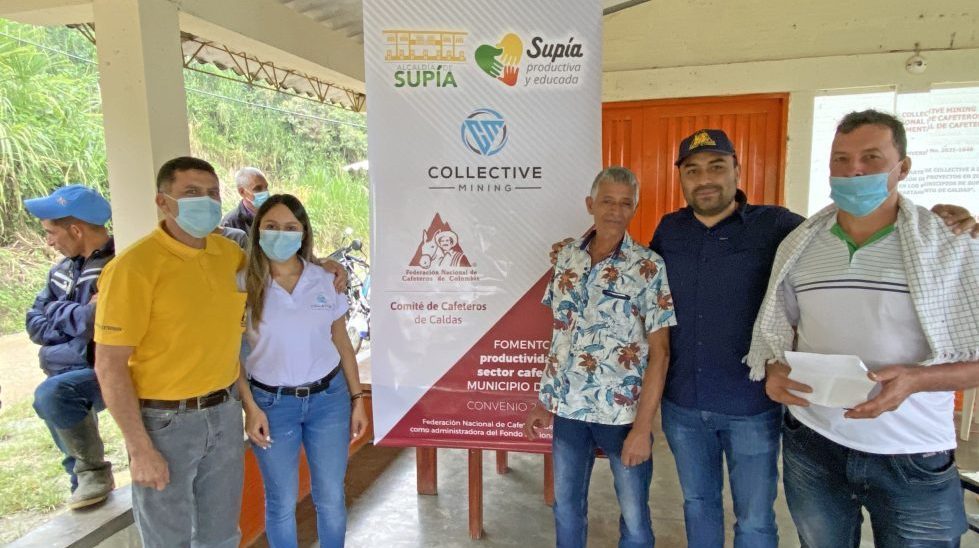
Collective Mining (TSXV:CNL) announced that it has signed an agreement with the Caldas Coffee Growers Committee and the municipalities of Supia and Marmato to jointly expand the program that helps to improve the quality of life of coffee growers and their families in Caldas. This alliance will benefit 1,652 coffee growers and their families as well as members of local communities.
The Committee is part of the National Federation of Coffee Growers of Colombia, a highly influential institution in Colombian agriculture that is responsible for overseeing the development of the country’s coffee industry.
Due to the success of the first program that took place in 2021, the parties involved in the alliance decided to expand the program and its activities under the terms of the previous agreement. Among the changes they made to the program was to expand the partnership to Marmato, one of the three municipalities that comprise the company’s projects.
Carlos Yesid Castro Marin, Mayor of Marmato, commented: “We are pleased to be part of this collaborative agreement and have the support of Collective Mining who articulated the initiative for the benefit of our mining communities”.
Collective Mining will contribute 32% of the total investment of the accumulated funds of the members of the strategic alliance, accumulated at $420,000 by 2022.
Marco Antonio Londoño Zuluaga, Mayor of Supía stated: “This is a very important step to promote sustainable development with the inclusion of mining activity. This project demonstrates that respectful and responsible mining is possible”.
These funds will be used to improve local infrastructure and coffee production by building aqueducts for the villages of Hojas Anchas and La Bodega.
Omar Ossma, CEO and President of Collective stated: “Caldas is the second largest coffee producing department in the country and it is well known as one of the traditional coffee regions in Colombia. Supporting the coffee industry and improving access to water for local communities are two pillars of our ESG strategy for 2022. This alliance aims to contribute to social development in the Caldas region while we keep our promise to create value and share it with the people where we explore our projects.”
The above references an opinion and is for information purposes only. It is not intended to be investment advice. Seek a licensed professional for investment advice. The author is not an insider or shareholder of any of the companies mentioned above.
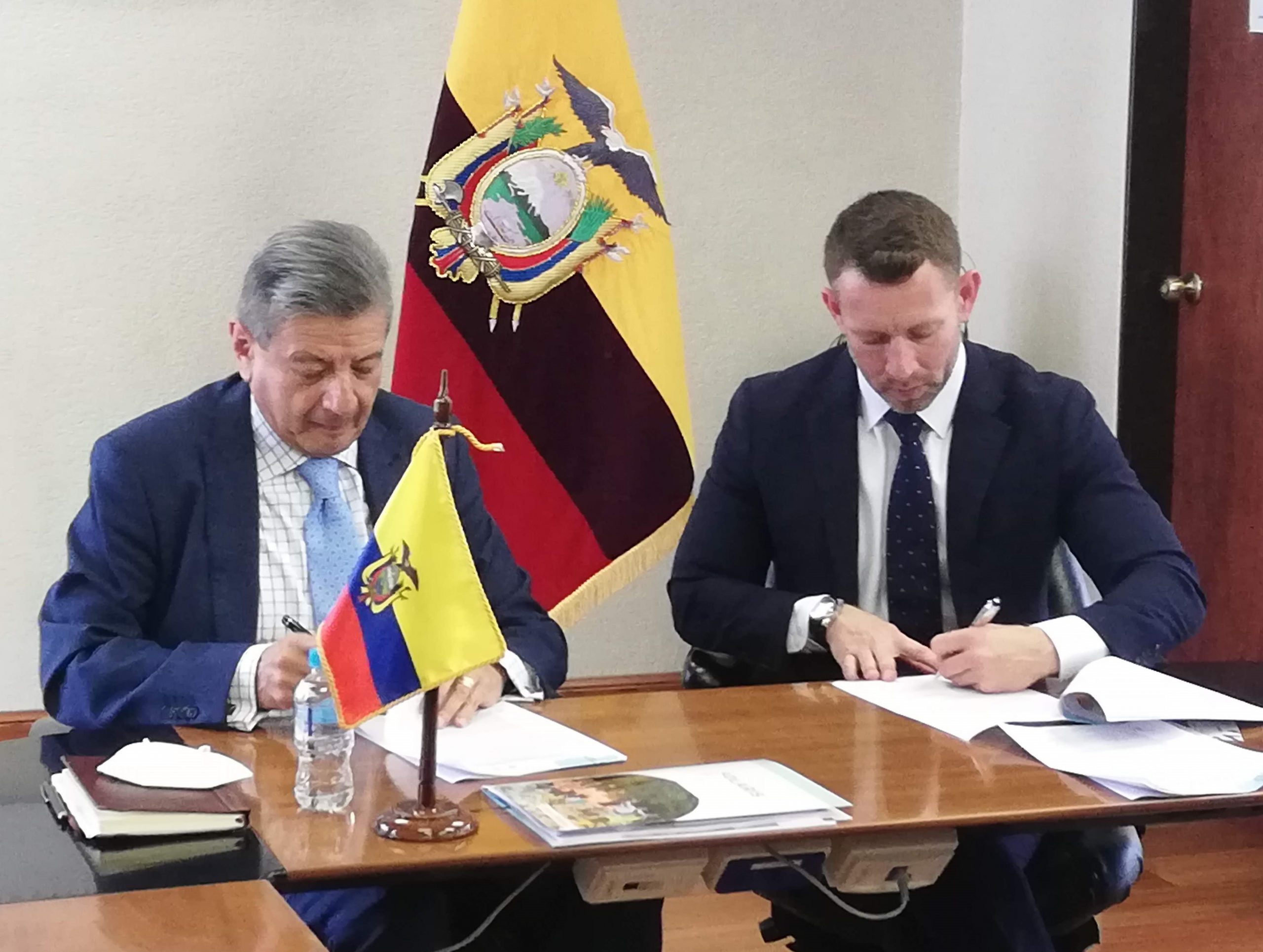
Solaris Resources (TSX:SLS) announced this morning the signing of a Memorandum of Understanding with Electric Corporation of Ecuador (CELEC) to provide low-cost, locally sourced hydroelectric power to the Warintza Project in southeastern Ecuador.
The Warintza Project is Solaris’ flagship exploration project, for which CELEC will provide locally-sourced hydroelectric power from the National Transmission System in Ecuador. This clean-power initiative will provide the primary power to the entire Warintza Project.
The adoption of this plan is aligned with the “Ecuador Zero Carbon Program” created by the Ministry of Environment, Water and Ecological Transition, as well as the National Decarbonization Pact, for which Solaris was one of the first mining signatories in September 2021.
Daniel Earle, President & CEO of Solaris Resources, commented in a press release: “The MOU with CELEC supports our vision to study the potential for electrified operations that maximize the structural benefits of the Warintza Project within an infrastructure-rich mining district with the aim of lowering costs, increasing efficiencies, reducing emissions, and broadly positioning the Project as a leading development opportunity across a range of financial and ESG metrics in the industry.”
Solaris aims to maximize the efficiency possibilities from this enormous, renewable, and low-cost energy source by investigating potential solutions for electrification of infrastructure, mobile mining equipment, including drills, trucks and shovels, material transportation and conveyance, such as gravity-assisted methods, and processing and pumping systems.
Mr. Gonzalo Uquillas Vallejo, General Manager of CELEC, also said: “As a leading strategic public company in the generation and transmission of electric power, we work in compliance with national guidelines to move toward the electrification of all areas of national industry, including large-scale mining, which will be a mainstay for the development of the Ecuadorian economy in the coming decades.”
Solaris has been singled out by the government for its commitment to best practices, and the Warintza Project is expected to set a new industry standard for low-cost, emission-free mining.
This announcement comes as good news for the Warintza Project and for Solaris Resources as a whole. Not only does it reduce the environmental impact of the project, but it also demonstrates Solaris’ commitment to working with the local community and government to create a sustainable future for all.
The above references an opinion and is for information purposes only. It is not intended to be investment advice. Seek a licensed professional for investment advice. The author is not an insider or shareholder of any of the companies mentioned above.
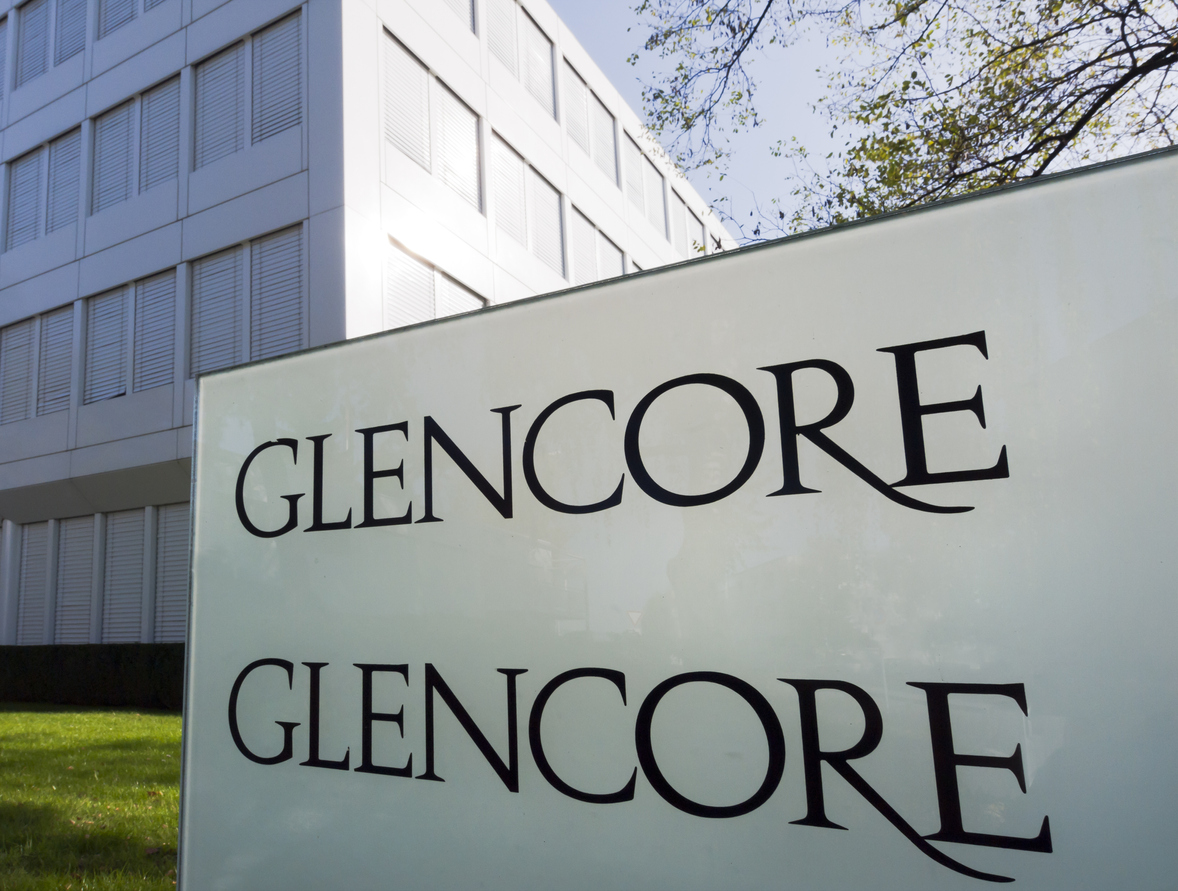
Metals Acquisition Corp., a blank check firm has signed a $1.1 billion deal to acquire Glencore’s (LON:GLEN) (OTC:GLNCY) CSA copper mine in Australia. After Perth-based IGO Ltd announced it would drop out of contention, Metal Acquisition became the leading contender to acquire the asset. After a year-long race, the deal is now a reality for the firm.
The purchase has given Metals Acquisition Corp 100% ownership and control of the mine’s operations, which will allow it to produce between 41,000 and 49,000 tons of copper per year. This gives the firm a good profit guarantee as copper is such an essential metal for the production of electric vehicles.
In addition, the high demand for copper and the lack of supply has caused copper prices to soar by more than 25% over the past year. According to experts, this trend will continue as more and more companies join the fight against climate change, making copper a more and more sought-after metal.
Metals Acquisition Chief Executive Mick McMullen said: “Copper is expected to play a key role in the global energy transition ‘megatrend,’.
Separately, Glencore announced that it has purchased 657,264 of its ordinary shares of USD 0.01 each on the London Stock Exchange and the Multilateral Trading Facilities of Morgan Stanley & Co. International Plc.
The purchase was completed on March 16, 2022. Glencore intends to hold the repurchased shares in treasury so the company now holds 1,408,178,868 of its ordinary shares in treasury and maintains 14,586,200,066 ordinary shares outstanding.
The purchase of the shares is part of the company’s share buyback program which is expected to be completed between February and August 2022.
Russian Review
Glencore recently announced that it will review business with Russia as the invasion of Ukraine has affected commodity markets.
Glencore has a 10.55% stake in En+Group, the Russian aluminum producer, as well as a 1% stake in Rosneft, the oil producer. This represents an investment value of $789 million and $485 million respectively by the end of 2021.
Increasingly, the list of companies cutting business ties and reviewing their operations with Russia is growing as foreign governments have lobbied for this to happen.
Glencore’s review is expected to bring further turmoil to the aluminum market as shipping companies have also suspended ship operations to and from Russia, causing supply chain issues for the global aluminum supply chain.
“Over time, global commodity trade flows will need to adapt to some or all of Russian/Ukrainian supply being unavailable, whether due to infrastructure damage, sanctions or ethical concerns,” Glencore said.
The above references an opinion and is for information purposes only. It is not intended to be investment advice. Seek a licensed professional for investment advice. The author is not an insider or shareholder of any of the companies mentioned above.
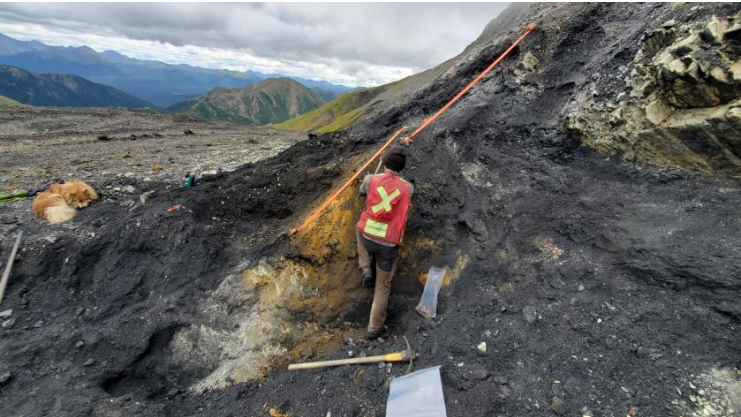
Honey Badger Silver (TSXV:TUF), a Canadian pure play silver company, announced last week that it has engaged Archer, Cathro, and Associates to complete a 3D geological modelling study to help develop and refine targets at the Plata Silver Property in east-central Yukon. Plata Silver is a 5,690 hectare property at which recent analysis showed compelling target areas for follow-up. The company expects results of the analysis to be released in coming weeks, after currently interpretations are finalized.
Chairman of Honey Badger Silver, Chad Williams stated in a press release, “Plata has produced high-grade silver from small-scale mining in the past and currently hosts 32 showings(2), many of which have returned high-grade silver, lead and zinc values, from drilling and trenching. My site visit to Plata last summer served to highlight the great potential of this property and we are delighted to be partnered with Archer Cathro, a highly regarded and sophisticated group of geoscientists that have had tremendous success in the Yukon over the past forty years. We look forward to leveraging their deep knowledge to identify the most prospective targets at Plata and in planning our Summer 2022 program.”
Following the extremely successful findings from the Company’s 2021 Field Program at Plata, which uncovered Keno Hill-style high-grade silver-lead-zinc values from a number of prospects that were evaluated and mapped, this study was commissioned. The Plata and Keno Hill regions, according to Archer Cathro geologists, have many similarities.
The second-largest silver producer in Canada is Keno Hill, located 165 kilometers west of the Plata Silver Property. Between 1913 and 1989, it produced more than 200 million ounces of silver at an average grade of 44 oz/t (oz/t). Alexco Resource Corp., which owns and runs the majority of Keno Hill’s historic mining operations, restarted concentrate production and shipments in the first quarter of 2021, with commercial output expected to begin shortly.
The following is a recap of highlights from the 2021 Plata Summer Work Program:
- Assays received confirmed the presence of Keno Hill-style high-grade silver including:
- 16,887 g/t silver and 67.99% lead from a rock sample (float) at the P1 Zone, 4,300 g/t silver, 22.00% zinc and 46.40% lead over 1.0 metre from a channel sample at the P2 Zone and 2,720 g/t silver, 72.63% lead from a rock sample (outcrop) at the P26 Zone associated with Type I veins;
- 4,500 g/t silver, 7.26 g/t gold and 24.13% lead over 0.85 metres from the Aho Zone, which extends over 800 metres along strike, associated with Type II veins;
- 5,190 g/t silver, 4.24 g/t gold, 24.4% lead and 3.62% zinc- obtained from composite grab samples from approximately 90 historic ore bags.
- The property hosts 32 hard rock showings that have seen minimal past exploration as well as eight strong multi-element soil anomalies suggesting additional zones along trend that have seen little to no follow-up work, which offer excellent potential for new discoveries.
Source: Honey Badger Silver
The above references an opinion and is for information purposes only. It is not intended to be investment advice. Seek a licensed professional for investment advice. The author is not an insider or shareholder of any of the companies mentioned above.
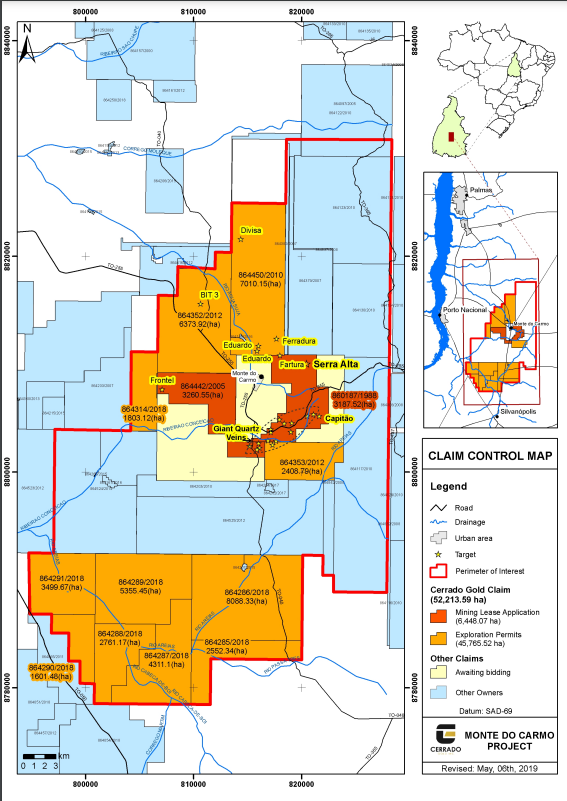
Canadian miner Cerrado Gold (TSXV:CERT) has signed a $20 million revenue funding agreement with Sprott Resource Streaming Royalty, which the company intends to use to fund ongoing work and deliver a reliability study for the Monte do Carmo gold property in Brazil.
The Monte do Carmo project, located east of Monte do Carmo, consists of 14 exploration permits covering a total area of 67,785 hectares.The project is expected to produce 149,000 oz per year during the first five years of operations.
Cerrado Gold CEO and co-chairman Mark Brennan said in a press release: “We are very pleased to be partnering again with Sprott to fully finance our feasibility study and development works at Monte do Carmo. The facility is a non-dilutive, attractive financing that allows full flexibility to add additional project financing for construction beginning in 2023.”
Under the agreement, Cerrado Gold will sell 2.25% of all gold and silver produced at the Sprott Resource property with the option to repurchase 50% of the agreed flow-through. This is based on a buyback program.
Sprott Resource issued a $20 million secured promissory note to Cerrado Gold with an interest rate of 10% per annum scheduled to mature on March 14, 2031 or upon achievement of commercial production from the project among other conditions.
Sprott managing partner Mike Harrison said: “The results of the Monte Do Carmo PEA Technical Report demonstrate a tier-one, high-return, low-cost gold project with excellent exploration potential in a good jurisdiction.
“This funding provides catalytic capital to advance the project to a construction decision, and also provides the opportunity for Sprott to provide construction financing as the company advances the project.”
Cerrado’s South American Project Pipeline
Cerrado Gold is a Toronto-based precious metals exploration and mining growth company with assets in South America. The Company’s 100% owned Minera Don Nicolas Project, located in Santa Cruz, Argentina, is a new producing gold and silver mine with significant optimization, expansion and exploration potential. The company is also focused on exploration at its 100% owned Monte do Carmo Gold Project in the state of Tocantins, Brazil, expanding the high grade mineral resource base through extensive exploration in 2022.
The above references an opinion and is for information purposes only. It is not intended to be investment advice. Seek a licensed professional for investment advice. The author is not an insider or shareholder of any of the companies mentioned above.

Collective Mining (TSXV:CNL) has announced this morning the results of the first three diamond drill holes at the Olympus Central Target. The Central Target is within the Guayabales project, in the Class department of Colombia.
Collective Mining presently has three diamond drill rigs working at Olympus, with two rigs testing the Olympus Central Target and one rig drilling on the Olympus South Target as part of its 2022 minimum 20,000-meter program. Prior to the end of March 2022, a fourth diamond drill rig is planned to start drilling at the Guayabales deposit.
The discovery marks an important milestone for the company and an exciting catalyst for investors who have been anticipating discovery news for some time.
Ari, Executive Chairman of Collective Mining, commented in a press release: “The broad intercepts from the initial drilling results at the Olympus Central Target represent a major gold and silver discovery within the Guayabales project. Our work to date has defined a large area of known mineralization and these results simply represent the beginning of drill testing within this target. With multiple drill holes advancing and plans to begin testing other major targets at Guayabales in the near term, including an outcropping copper and gold porphyry system at the Victory Target, there is much to look forward to as our fully funded drill program advances in 2022.”
Highlights from the discovery are as follows:
- The Olympus Central discovery hole, OLCC-3, was drilled to the northwest at a 60-degree angle to the center of an induced polarization chargeability anomaly. The drill hole totalled 630.5 metres in length and intersected mineralization up to a vertical depth of approximately 400 metres. Two distinct zones of broad mineralization were encountered in the drill hole.
- The first zone in OLCC-3 (“Eastern Zone”), which began near surface in a quartz diorite porphyry intrusion, contains multiple high grade, carbonate-base metal veins (“CBM”) enveloped by broad sericite-pyrite, lower grade halos with results as follows:
- 301.9 metres @ 1.11 g/t gold equivalent from 61.7 metres depth including 1.3 metres at 74.91 g/t gold equivalent with visible gold observed within this CBM vein.
- The second zone in OLCC-3 (“Western Zone”), which is located further down hole and is hosted within country rocks (schists and metasediments), is impregnated by multiple zones of sheeted CBM veins and enveloped by sericite-pyrite alteration as follows:
- 34.2 metres @ 0.90 g/t gold equivalent from 486 metres depth including 0.5 metres @ 12.68 g/t AuEq.
- OLCC-3 ended in high-grade mineralization with the final sample from 630-630.5 metres depth averaging 0.5 metres @ 7.64 AuEq.
- OLCC-1 was drilled steeply to the west at an 80-degree angle into the southern periphery of the induced polarization chargeability anomaly and intercepted a broad zone of mineralization in the Eastern Zone beginning near surface as follows:
- 116.3m @ 1.03 g/t gold equivalent from 30.6 metres depth including 9.6 metres @ 8.05 g/t gold equivalent with visible gold observed locally.
- OLCC-2 was drilled to the southwest at a 60-degree angle and only intercepted sporadic and moderate mineralization. The hole was drilled outside of the induced polarization chargeability anomaly into an area now interpreted to be a late intrusion dyke that has stoped-out mineralization in a small area at this location.
- The Olympus target (South, Central and North) covers an area of 1.25 kilometres by 0.75 metres and remains open for expansion.
- Three additional drill holes have been completed to date with assays pending while another three drill holes are currently advancing within the Olympus Central Zone. As a result of the new grassroots discovery at Olympus, the Company plans to accelerate drilling in 2022 by stepping out along the Eastern and Western Zones of mineralization at various elevations.
- There are over 50 historical and current artisanal mines that have been identified within the Olympus target to date and drilling completed thus far by the Company has not tested below the vast majority of these mines as the discovery hole, OLCC-3, was drilled in the northern extension of the system. As announced previously, grab samples from within artisanal workings found significant high-grades precious and base metal bearing CBM veins (see press releases announced sampling results dated December 1, 2021, December 14, 2021, and January 12, 2022).
- A short overview video of the drill core in discovery hole OLCC-3 has been prepared by David Reading, Special Advisor and QP under NI 43-101 and can be viewed by clicking here or by copying and pasting the following link into your browser https://youtu.be/sPUyg6GEIoA
Source: Collective Mining
Table 1: Assay Results for drill holes OLCC-1 – OLCC-3

Figure 2: Plan View of the Olympus Central Target

Figure 3: Cross section W-E of Olympus Central Target
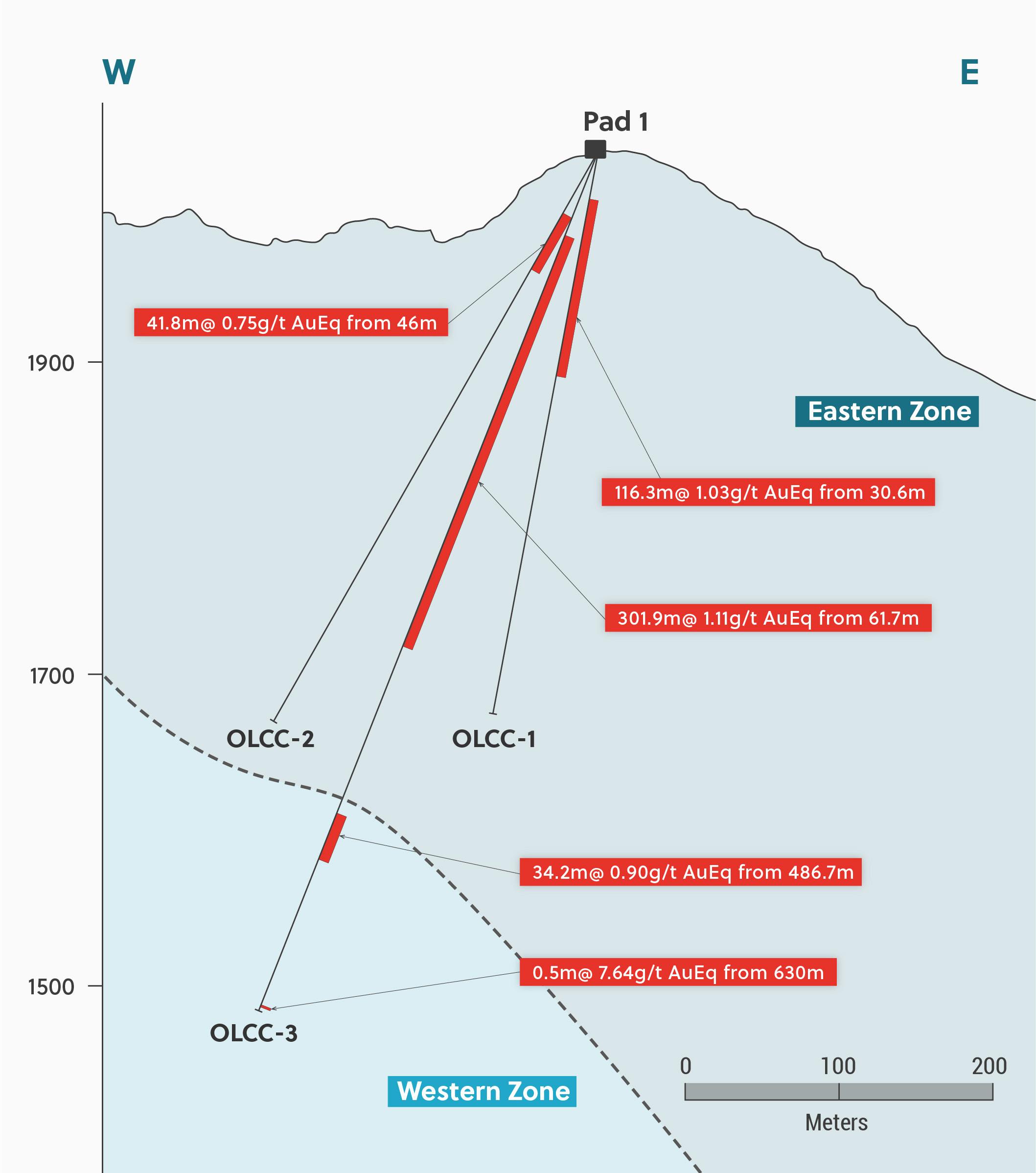
Figure 4: Drill Hole OLCC-3 at 196 metres Depth: CBM Vein with Visible Gold, Sphalerite, Chalcopyrite and Pyrite (red circles indicate areas where visible gold is observed)

A New Approach
Collective Mining also recently announced that it was quickly advancing its high-resolution and deep-penetrating Induced Polarization survey over the Pound Target at the San Antonio project. The survey is progressing according to schedule and the company expects it to be finished in March 2022.
Ari Sussman, Executive Chairman of Collective commented in a press release: “Our San Antonio project has the potential to yield multiple mineralized porphyry and breccia systems. Following on from the exciting grassroots discovery at Pound, we are focused on defining the morphology of this sulphide rich breccia body and other potential porphyry systems. Once the IP results have been interpreted and incorporated with all newly generated data, the Company will provide details on the next phase of drilling for the project in 2022.”
The above references an opinion and is for information purposes only. It is not intended to be investment advice. Seek a licensed professional for investment advice. The author is not an insider or shareholder of any of the companies mentioned above.
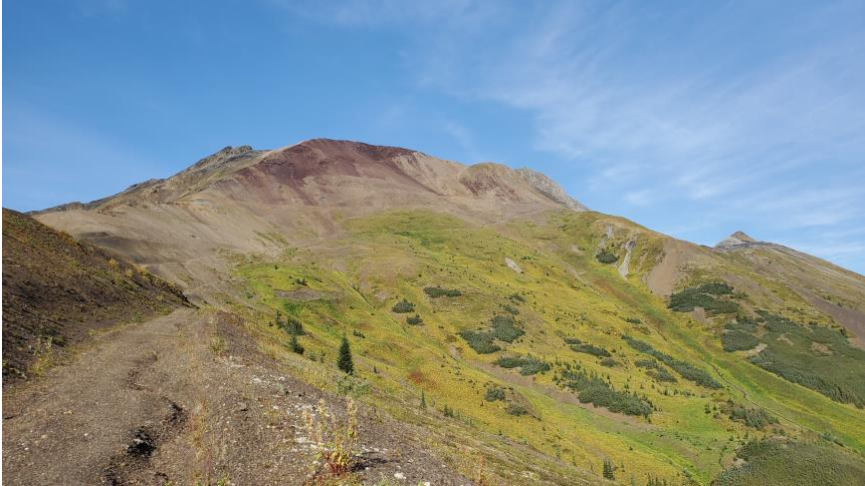
As 2022 rolls on, investors are looking for edge anywhere they can get it. With current uncertainty in commodities markets and the mining industry, there are few unique opportunities left. However, investors looking for a pure-play silver company in a stable mining jurisdiction may have any option in Honey Badger Silver (TSXV:TUF) (OTC:HBEIF).
Honey Badger is a public Canadian pure-play silver mining company headquartered in Toronto, Ontario, engaged in the identification, acquisition, development and integration of cumulative silver ounce transactions. Silver’s resiliency and safe-haven asset status during a period of intense struggle for the mining industry overseas could give investors plenty of alpha in the coming quarters.
The company has a dominant land position in Ontario’s Thunder Bay Silver Historic District, which covers 16,800 hectares. The Honey Badger group of properties covers some of the most productive veins in the Thunder Bay silver district. Honey Badger also has advanced projects in the southeastern and south-central Yukon, positioning it as a premier silver company.
Honey Badger’s mission is to produce silver and other precious metals safely, sustainably and profitably. The company and its highly experienced team is focused on being the world’s leading producer of precious metals, thus creating value for its shareholders through engineering, innovation and sustainable development.
The Thunder Bay Silver Project
The Honey Badger land parcel in Thunder Bay is home to 12 high-grade mines that have had a historical production of 1,667 million ounces of silver.
The company’s Silver mountain/Mink property is located approximately 50 meters south of the Silver Mountain group of deposits, which produced 700,000 ounces of silver between 1888 and 1903. Its geological history and the general geological setting of this project make it in a primary target for the discovery of high grade polymetallic silver mineralization (cobalt, zinc and lead)
Polymetallic silver deposits are found in two main districts of Ontario; the Timiskaming near the town of Cobalt (the Cobalt Silver District); and the northwestern Lake Superior near the town of Thunder Bay (the Thunder Bay Silver District).
A report filed with the Bureau of Mines in 1913 (REPORT OF THE BUREAU OF MINES VOL. XIX., PART II., The Cobalt-Nickel Arsenides and Silver Deposits of Temiskaming (Cobalt and Adjacent Areas), WILLET G. MILLER, Provincial Geologist , 1913) compared minerals from the Port Arthur silver mines (Thunder Bay, ON) with those from the Temiskaming veins (Cobalt, ON) and found the following points in common:
- Native elements: Native silver, native bismuth, graphite .
- Arsenates: cobalt flower, annabergite.
- Sulfides: Argentite, zinc blende, galena, pyrite, marcasite, pyrrhotite, chalcopyrite, copper gaze.
The geological attributes of the area and spatial distribution of the polymetallic silver mines, the samples, suggest a good potential to discover new high-grade polymetallic silver veins in the region.
Promising discoveries have been made in exploration programs that Honey Badger began in 2018:
- Random samples* taken at the property’s 12 historic mines returned up to 1,503 g/t silver and 14.94% zinc.
- Drilling identified multiple zones of near surface cobalt mineralization with no arsenic (0.26% cobalt over 10.8 meters in BM-18-004) and high grade silver mineralization (1254 g/t silver in BM-18-006).
Source: Honey Badger Silver
Honey Badger Announces Third Silver Assay Results
Honey Badger recently announced rock, chip and rock sample analysis results from the 2021 field program at its 5,690-hectare Silver Property, 100% owned by Honey Badger, located in west-central Yukon.
Highlights of silver, lead and zinc assays from trench and chip sampling at the P2 Zone are listed below:
- 4,300 g/t silver, 46.4% lead and 22% zinc over 1.0 meter
- 1,775 g/t silver, 48.78% lead and 13.35% zinc over 1.2 meters
- 1,140 g/t silver, 24.16% lead and 16.41% zinc over 2.49 meters
- 12,806 g/t silver, 76.08% lead and 3.70% zinc over 0.10 meter
Highlights of silver, gold, lead and zinc assays from rock samples collected from outcrop and float material at the P1, P6 and P26 Zones are listed below:
- P1 Zone: 16,887 g/t silver, 0.18 g/t gold, 67.99% lead and 0.83% zinc (float)
- P6 Zone: 7,950 g/t silver, 1.55 g/t gold, 57.66% lead and 0.99% zinc (outcrop)
- P6 Zone: 4,510 g/t silver, 6.91 g/t gold, 25.73% lead and 2.05% zinc (float)
- P26 Zone: 2,720 g/t silver, 0.32 g/t gold, 72.63% lead and 0.43% zinc (outcrop)
These latest results, in conjunction with the first two batches of assay results previously reported confirm:
- high-grade silver in Type I veins at the P1, P2 and P26 Zones , and
- high -grade gold-bearing silver in Type II veins at the Aho and P6 Zones,
- very high-grade silver and gold was mined by historic miners
Source: Honey Badger Silver
Honey Badger Reports Second Batch of Yukon Silver Program Assays
The company also recently reported assays out of its Yukon Silver Program;
Highlights of silver, gold, lead and zinc Assays from five channel and chip samples collected from the Aho zone at Plata are listed below:
- 4,500 g/t silver, 7.26 g/t gold, 24.13% lead, 0.83% zinc over 0.85 meters;
- 3,480 g/t silver, 4.63 g/t gold, 23.79% lead, 2.05% zinc over 1.6 meters;
- 1,546 g/t silver, 3.28 g/t gold, 5.04% lead, 0.09% zinc over 1.45 meters;
- 868 g/t silver, 5.30 g/t gold, 7.47% lead, 1.95% zinc over 1.93 meters; and
- 202 g/t silver, 3.69 g/t gold, 1.12% lead, 10.1% zinc over 1.32 meters.
In addition, gold assays have been received for five composite grab samples of hand sorted material collected from 90 ore bags left behind by historic miners at Plata. These are reported below in conjunction with silver, lead and zinc assays previously reported by the Company on December 13, 2021:
- 4.25 g/t gold, 5,190 g/t silver, 23.4% lead and 3.62% zinc;
- 7.56 g/t gold, 4,820 g/t silver, 13.15% lead and 2.78% zinc;
- 6.24 g/t gold, 4,000 g/t silver, 20.97% lead and 3.41 g/t zinc;
- 2.67 g/t gold, 3,500 g/t silver, 17.5% lead and 3.07% zinc; and
- 5.61 g/t gold, 2,930 g/t silver, 10.5% lead and 2.26% zinc.
Plata lies within the Tintina Gold Belt and displays numerous similarities to the world-class Keno Hill Mining Camp, Canada’s second largest primary producer of silver, located 165 km west of the Plata Silver Property. Keno Hill produced more than 200 million ounces of silver at an average grade of 44 ounces per ton (oz/t) of silver from approximately thirty-five vein deposits between 1913 and 1989 (1).
Source: Honey Badger Silver
As the conflict in Ukraine rages on and global markets stumble, assets like silver, and silver mining stocks may be one of the best places to park money for the long-term. As a result, Honey Badger Silver (TSXV:TUF) (OTC:HBEIF) may be the ultimate pure-play silver mining stock for 2022.
The above references an opinion and is for information purposes only. It is not intended to be investment advice. Seek a licensed professional for investment advice. The author is not an insider or shareholder of any of the companies mentioned above.
In a March 10th release, Wheaton Precious Metals (NYSE:WPM) (TSX:WPM) announced record revenue, earnings, and operating cash flow for 2021. Adjusted Q4 EPS of $0.29 missed the consensus estimate by $0.02. Q4 revenue of $278.2 million missed by $9.79 million.
Silver was Wheaton’s best performing metal in terms of total sales. While nearly all major precious metal equities have performed well with the gold price so far in 2022, Wheaton’s position as a steaming company with significant silver exposure may set it apart in the longer term.
Results and new streams
Attributable production in 2021 was 752,958 GEOs. Production guidance for 2022 is 700,000-760,000 GEOs. Average cash costs in Q4 were $429 per GEO with operating margins at $1,377.
Total attributable reserves (proven and probable) for all metals increased by 13% due to recent precious metal purchase agreements (PMPAs) and increases at Vale’s Salobo mine in Brazil.
In Q4, Wheaton announced a PMPA on silver production on Artemis Gold’s Blackwater Project in British Columbia and acquired the existing PMPA on gold production, held by New Gold Inc. They also announced a new gold and platinum PMPA on Generation Mining’s Marathon Project in Ontario. So far in 2022, they’ve announced new PMPAs on Adventus Mining’s Curipamba Project and Sabina Gold & Silver Corp.’s Goose Project.
“Over the past three months alone, we added five new streams to our already robust portfolio. This additional growth is readily apparent in our ten-year production forecast, where we see annual production climbing to well over 900,000 gold equivalent ounces,” said CEO Randy Smallwood.
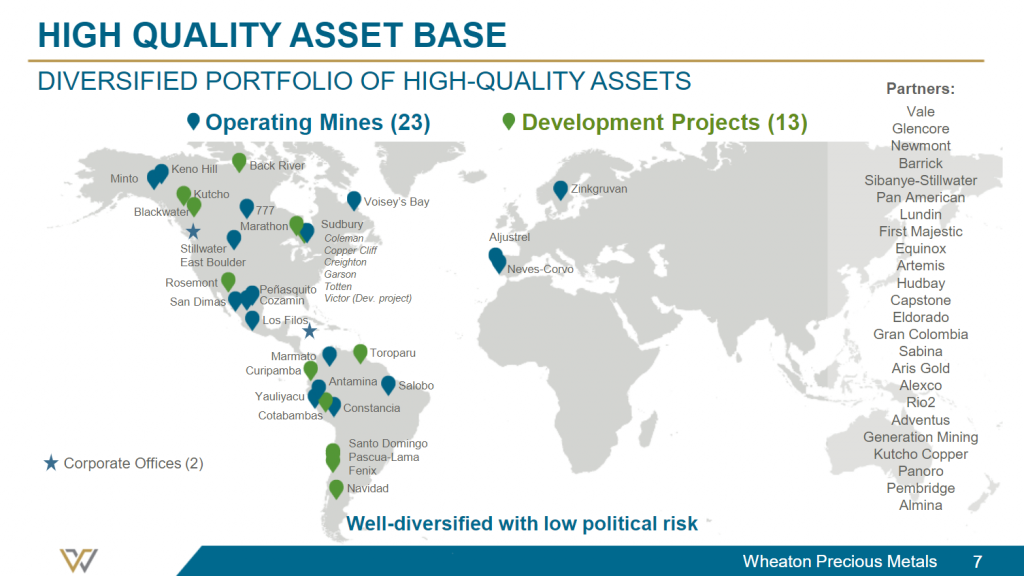
Source: wheatonpm.com
Silver and PGM exposure
Wheaton has revenue streams from gold, silver, palladium, and cobalt. Of the $1.2 billion 2021 sales, $573.4 million (47.7 percent) was from silver. Gold accounted for 46.8 percent and PGMs and cobalt were 3.8 and 1.7 percent, respectively.
This gives Wheaton significantly more silver exposure than other large PM royalty and streaming companies. By comparison, for Franco Nevada (NYSE:FNV) TSX:FVN) silver accounts for about 17.3 percent of sales. For Royal Gold (NASDAQ:RGLD), silver is only about 10 percent.
With an average cash cost of $5.78 per ounce and realized price of $25.08 in 2021, silver also delivered higher operating margins (77 percent) for Wheaton compared to gold (74 percent).
“Silver just has so many more attributes behind it in terms of what it’s used for…. Silver has the strongest fundamentals because so much of it is consumed on the industrial side yet it still acts as a precious metal, a store of value,” says Smallwood.
The recent run-up in palladium has drawn attention to Wheaton’s PGM exposure. Wheaton has a 4.5 percent stream on the Stillwater mine in Montana, which is the largest primary producer of PGMs outside of South Africa and Russia. Wheaton’s latest statements also reported platinum reserves for the first time due to the new PMPA on the Marathon Project.
Appeal of streaming as producers face cost pressures
As inflationary pressures, particularly energy costs, eat into margins for producers, streaming and royalty companies are better positioned to benefit from recent precious metal price action.
While some of the major royalty and streaming companies (such as Royal Gold and Sandstorm) have outperformed the Gold Miners ETF (NYSEARCA:GDX) so far in 2022, Wheaton and Franco Nevada have tracked it closer. Gold and silver spot prices have recently been moving in lockstep, but any breakout in silver could set Wheaton apart from its peers.
The above references an opinion and is for information purposes only. It is not intended to be investment advice. Seek a licensed professional for investment advice. The author is an insider or shareholder of one or more of the companies mentioned above.
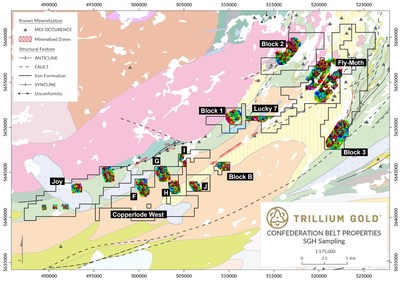
Kinross (NYSE:KGC), the senior Canadian gold producer, announced in on February 24, 2022 the completion of the plan of arrangement to acquire all of the issued and outstanding shares of Great Bear Resources for C$1.8 billion. The company’s primary asset, the Dixie project, where drilling has revealed world-class structures, includes 9.14 ha of contiguous deposits extending over 22km and is one of the largest and most exciting discoveries in recent years.
J.Paul Rollinson, president and chief executive officer of Kinross said, “The closing of the acquisition of Great Bear Resources represents a milestone for Kinross as we advance our future growth strategy. We are excited to add such a high-quality asset in a top mining jurisdiction to our global portfolio.”
“The Dixie project represents an exciting opportunity to develop a potentially world-class deposit into a large, long-life mining complex.”
Trillium Gold’s Dominant Land Package
The massive deal underscores the importance and potential of the Red Lake Mining District, an area where Trillium Gold Mines (TSXV:TGM), a gold exploration company with a dominant land package in the area is operating.
Along the same structural trend as the Dixie deposit, Trillium Gold recently announced a definitive agreement to acquire a massive contiguous land package over a major part of the Confederation Belt that covers more than 100 km of structure. Trillium’s land package is not only on-trend, but is the largest land assemblage in the area. Considering the size and potential of the Confederation Belt land package, the potential for multiple Dixie-size discoveries is within the company’s midst. The definitive agreement is seen as an important step in strengthening the Company’s strategic advantage to consolidate the greenstone belt and position it as the most dominant exploration company in the Red Lake Mining District.
In January 2022, the Company reported results from 17 SGH (spaciotemporal geochemical hydrocarbon) regional soil sampling grids on its Confederation belt properties which identified numerous gold pathfinder anomalies that will serve as priority targets for Trillium Gold’s second phase of exploration work in the 2022 field season. The newly identified relationships among SGH-generated gold targets, historical gold assays and possible structural and lithological controls, effectively launch Trillium Gold’s Confederation belt properties into a new era in gold exploration.
The Willis Property
In addition, Trillium recently acquired a key land package southwest of its 100% owned Newman Todd Complex, a project initially being advanced towards open-pit mining, with depth potential to the southwest known as the Willis Property, comprising thirteen patented mineral licenses totalling 229 hectares.
As with the Newman Todd Property to the north, Willis shows many similarities to the major eastern gold mines: namely, rock types, structures, mineralization and alteration. Despite these attributes, the property has seen very little exploration since the 1930s and is one of the few remaining unexplored properties in the Red Lake greenstone belt.
As Trillium Gold continues to settle into its position as the most dominant exploration company in Red Lake, investors will continue to watch closely for the high potential at its Red Lake property portfolio the company has amassed over the past 12 months.
The above references an opinion and is for information purposes only. It is not intended to be investment advice. Seek a licensed professional for investment advice. The author is not an insider or shareholder of any of the companies mentioned above.

First Uranium Resources (TSX:FCU) has signed a binding letter of intent (LOI) to acquire all of the shares of US-based Southwind Corporation. First Uranium Resources has announced that it has signed a binding letter of intent to acquire Southwind Corporation, which owns a phosphate and heavy rare earths development project in the central US.
Southwind CEO Paul Barrett commented in a press release: “We are delighted to be partnering with First Uranium on this exciting project, with combined potential for two vital commodity streams – phosphates and rare earths. First Uranium’s participation will accelerate the development of this near-surface stratiform deposit, situated in the heart of the US Midwest, which has excellent potential to feed into the agricultural and high-tech metals sectors, both of which are experiencing sustained and long-term growth in feedstock demand.”
Some of the project characteristics include:
- Phosphate grade is at top end of US producing phosphates (based on the US Geological Survey)
- REE enrichment is highest in USGS database (based on the US Geological Survey)
- Above 20 worldwide REE projects in terms of anticipated volume
- Above 15 worldwide projects in terms of Grade
Source: First Uranium Resources
According to the agreement, First Uranium will have the option to acquire a 100 percent stake in the US-based company, issuing up to 20 million of its shares.
A typical technical report will include a significant amount, if not all, of the work that must be completed by First Uranium in order to begin production. Furthermore, First Uranium will have at least $3 million in project expenditures within the first year after the conclusion of the technical study.
Private Placement Investment
The company also unveiled private placement of up to $6m in subscription receipts. Proceeds of the placement, which is planned to close on or about 31 March 2022, will be used for the firm to fund exploration and development work on its Arkansas project.
Heavy Rare Earths are important to many industries, and China has a near-monopoly on the production of them. The US has been looking for new sources of these materials, and this project looks very promising. First Uranium is well-positioned to develop this project and this should be able to provide some much-needed supplies for these critical materials.
Heavy rare earths include :
- Lanthanum
- Cerium
- Praseodymium
- Neodymium
- Samarium
- Europium
- Gadolinium
- Terbium
- Dysprosium
- Holmium
- Erbium
- Thulium
- Ytterbium
- Lutetium
These are often used for catalysts, magnets, glass, and phosphors. They are important in many industries, including auto manufacturing, green energy, and electronics. This project could help reduce the dependence on China for these materials as the US looks to expand its homegrown materials industry amid a transition to green energy technologies and expands its national network of charging stations for electric cars.
The above references an opinion and is for information purposes only. It is not intended to be investment advice. Seek a licensed professional for investment advice. The author is not an insider or shareholder of any of the companies mentioned above.

Tier One Silver (TSXV:TSLV), the Canadian exploration company believes it has initiated the first drilling stage of a new discovery in Peru. The Curibaya project is 100% owned by Tier One Silver. Tier One Silver completed the first Curibaya drill program located in northwest Peru 48 kilometers northeast of the provincial capital, Tacna, near the Chilean border.
Drilling on the project comprised 16 holes intercepting bonanza grade silver mineralization. Highlights included drillhole 21CUR016, which intersected seven metres grading 272.3 grams silver per tonne, 0.33 gram gold per tonne, 0.046% zinc, and 0.03% lead (299.1 grams silver-equivalent per tonne) from 139 metres downhole, including a higher grade core of 1.5 metres of 1,128.7 grams silver, 1.04 grams gold, 0.15% zinc, and 0.09% lead (1,213.7 grams silver-equivalent).
Tier One Silver CEO Peter Dembicki said that Curibaya, “hosts a major intermediate-sulphidation epithermal system that lies on the border between an epithermal belt and a world-class, prolific coastal porphyry belt. The drill results indicate that the project has the potential to host both a large-scale, high-grade silver deposit and porphyry deposit.”
The Curibaya property comprises some 16,800 hectares located in a porphyry copper belt where some of South America’s largest porphyry deposits are located, including Freeport McMoRan’s Cerro Verde deposit, the Cuajone and Toquepala Southern Copper deposits and Anglo American’s Quellaveco deposit.
In 2020, the company conducted a magnetic survey that identified a two kilometer by 750 meter chargeability anomaly near the surface that is believed to be a precious metal target.
Tier One Silver has identified the age of the mineralization at Curibaya to be Paleocene, ranging from approximately 55 to 61 million years old. The company’s technical team believes that the Paleocene age of the mineralization supports the potential for a world class discovery at the Curibaya project.
The Curibaya mineralization occurs in the dome complex in the center of the property and several structural corridors (Tipal, Sama, Madre, Sambalay, Cambaya I and Cambaya II) over a four by five kilometer alteration system.
Tier One Silver plans to restart drilling on the property in May when the rainy season comes to an end. Drilling will focus on higher elevation targets in the Sambalay, Tipal and Cambaya systems.
“The second phase of drilling is going to be very exciting for us,” said Christian Rios, the company’s senior vice president of exploration. “We will be able to drill the high priority Cambaya target area, where we’ve seen the best channel samples to date, and continue to explore targets along the mineralised corridors to further increase our confidence that Curibaya could deliver a significant discovery.”
In December Tier One Silver is also advancing Hurricane Silver, a project that hosts numerous high-grade silver occurrences located some 66 kilometers north of Cusco. Dembicki said that Hurricane Silver “offers the potential to make a second world-class discovery in Peru.”
The above references an opinion and is for information purposes only. It is not intended to be investment advice. Seek a licensed professional for investment advice. The author is not an insider or shareholder of any of the companies mentioned above.
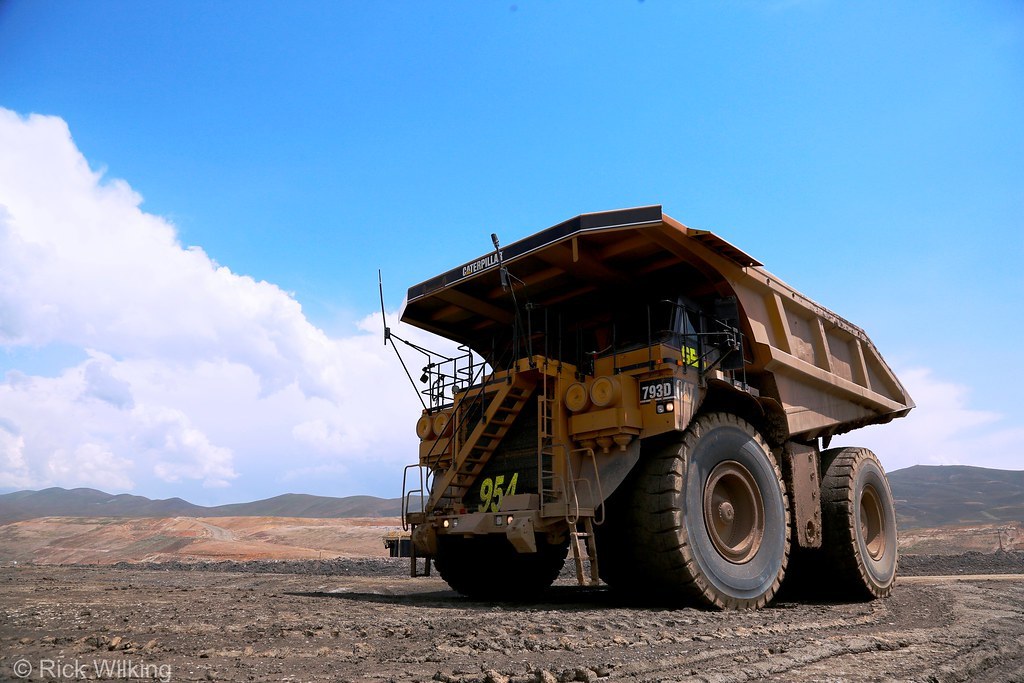
The Government of Yukon and the Government of Canada have approved in partnership with Yukon First Nations, the Coffee Gold project. The Yukon government completed a consultation with the Selkirk First Nation, Tr’ondëkHwëch’in Government, White River First Nation and Na-ChoNyäk Dun First Nation to make the decision. The Yukon government looks forward to further engagement and consultation with First Nation governments in considering regulations related to the project.
Yukon Premier Sandy Silver said “”The Coffee Gold project will provide significant employment opportunities for many Yukoners and contribute to the territory’s growing economy. Through our ongoing engagement with Yukon First Nations and our collaboration with the Government of Canada, we look forward to supporting the next stages in the development of the Coffee Gold project.”
The Coffee Gold project is an open-pit, heap leach development project consisting of four gold mines in west-central Yukon proposed by Newmont Corporation. The Latte, Double Double, Supremo and Kona mines are located 130 km south of Dawson City; plus a permanent waste rock storage facility.
In a stock transaction in 2016, Goldcorp acquired Kaminak Gold and its Coffee Gold project for approximately C$520 million when it was in the exploration stage. Goldcorp was subsequently acquired by Newmont (NYSE:NEM).
The project, with an operating life of ten years, will be constructed over a 30-month period, providing approximately 700 jobs during peak construction.
Canada’s mining industry is pressing ahead with a run of new projects and reopenings for existing mines. As the country lifts restrictions and returns to full operations for most companies, the mining industry is looking to return to normal drilling operations and output for producers.
The above references an opinion and is for information purposes only. It is not intended to be investment advice. Seek a licensed professional for investment advice. The author is not an insider or shareholder of any of the companies mentioned above.
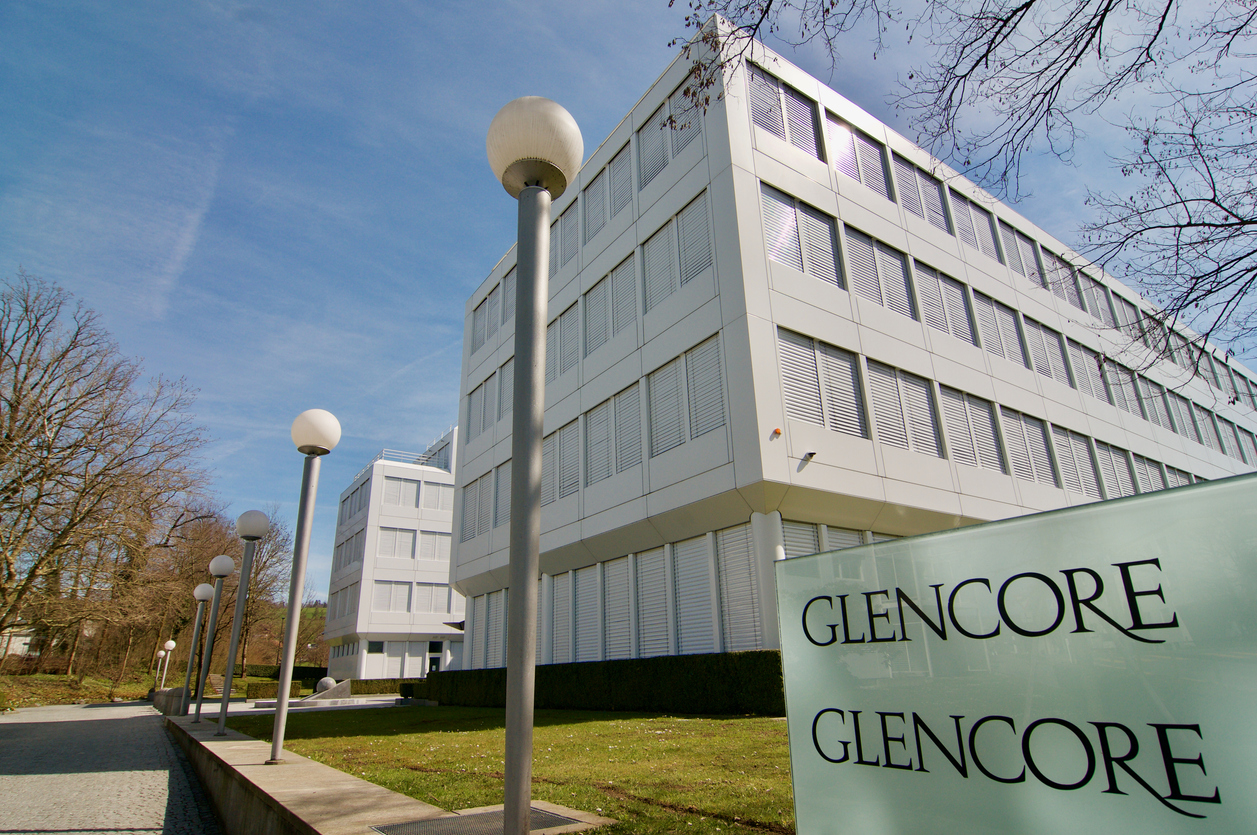
Glencore (OTC:GLNCY), the world’s largest commodity trader and miner, is reconsidering its business activities in Russia following the Russian invasion of Ukraine.
Among the activities under review is Glencore’s shareholding in the Russian hydroelectric and aluminum group En+Group, which has an annual production capacity of 3.9 million tons and is controlled by United Co. Rusal International PJSC, and about 0.5% of Rosneft.
This move by Glencore came after a variety of Western companies linked to Russian companies announced to cut ties with the country following Russia’s invasion of Ukraine. This due to pressure from governments and shareholders following the invasion.
The Swiss-based trader is also a major trader of aluminum maker Rusal’s metal and also trades some other Russian commodities including its oil. Glencore currently holds a 10.55% stake in En+Group, Rusal’s majority shareholder, and also owns a small 1% stake in oil major Rosneft.
In 2020 Rusal announced an agreement to sell aluminum to Glencore for US$16 billion which benefited the company by selling a third of its production to the trader. The deal was originally to run until 2024 with an option to extend it to 2025, Rusal stated at the time.
As already mentioned Glencore was also buying oil from Rosneft although the volume figure has not been disclosed.
Glencore at the end of 2021 announced in a press release the results of the value of these shares which were US$789 million and US$485 respectively.
Glencore in a press release stated, “We have no operating footprint in Russia and our trading exposure is not material to Glencore. “We are reviewing all our business activities in the country, including our shareholdings in En+ and Rosneft.”
Glencore also stated that it condemned the Russian government’s actions against the people of Ukraine and said, “The human impact of this conflict is devastating. Glencore is looking to see how we can best support humanitarian efforts for the people of Ukraine.”
The aluminum market has also been affected by Glencore’s decision as shipper AP Moller-Maersk A/S said it has halted ship bookings to and from Russia which increases supply turmoil for buyers already suffering the ravages of shortages.
Glencore’s business review also marks a radical shift in Glencore and Russia’s relationship as former Glencore CEO Ivan Glasenberg, received Russia’s Order of Friendship from President Vladimir Putin in 2017 in recognition of the company’s role in the privatization of Rosneft.
With the current destabilization of the Russian economy, mining companies are quickly rethinking their strategies, with many of them pulling out of the country entirely for the time being. Others will be able to operate for now, but may be weighing the risks of the unstable, unpredictable situation before making further decisions.
The above references an opinion and is for information purposes only. It is not intended to be investment advice. Seek a licensed professional for investment advice. The author is not an insider or shareholder of any of the companies mentioned above.

Collective Mining (TSXV:CNL) has announced this morning the completion of the first three drill holes in the Olympus Central target of the Guayabales project, Colombia with a total of 1,423 meters. Assay results are expected in the coming days and are an important catalyst for the company and the stock.
The Olympus target is divided into three zones called Olympus Central, Olympus South and Olympus North which together measure approximately 1.25 km x 0.75 km.
As part of its minimum 20,000-meter program for 2022, Collective Mining has three diamond drill rigs operating at Olympus and a fourth rig is expected to commence drilling at the Guayabales project shortly before the end of March.
“This initial drill program at Olympus represents the first holes drilled on the Olympus Central target and we are excited about the multiple styles of mineralization over potentially wide intercept lengths. Visually, the intersection of multiple CBM-bearing vein zones at the Olympus Central target shares numerous features with the multi-million ounce gold-silver Marmato deposit. We will continue to be aggressive with drilling through the remainder of 2022 and are excited about the initial near-term assay results,” commented Ari Sussman, CEO of Collective
The geological log from the drill holes highlights the following important data:
- Two distinct zones of mineralization have been identified to date resembling historical underground adit sampling which primarily are rich in gold and silver.
- The first zone, which consists of a matrix that includes sericite-pyrite alteration associated with a stockwork of carbonate base metal (“CBM”) veins has been intersected in holes OLCC1 and OLCC3. This zone was intersected up to 360 metres in downhole length in OLCC3.
- The second zone, consisting of country rocks (schists and metasediments) impregnated by multiple zones of sheeted CBM veins, was intersected further downhole in OLCC3 from 485 metres in depth and is up to 150 metres in length. The hole was terminated at a 633 metres depth with a CBM veinlet observed at the end of the hole.
- Mineralization in drilling to date has been intersected over a vertical depth of approximately 400 metres.
- IP chargeability anomalies are coincident with the sulphide mineralization in the Olympus Central target.
- OLCC1 was drilled at the southern periphery of the Olympus Cental chargeability anomaly and intersected the most abundance of sulphides while within the chargeability anomaly.
- OLCC2 almost immediately drilled out of the Olympus Central chargeability anomaly and only intercepted sporadic sulphide mineralization
- OLCC3 was drilled into the centre of the Olympus Central chargeability anomaly to a total depth of 633 metres and intercepted the strongest visual mineralization to date.
- Stepout drilling continues with holes OLCC4, OLCC5 and OLCC6. All holes are advancing well and are intersecting sulphide mineralization including CBM veins.
Source: Collective Mining
Figure 2: Plan View of the Olympus Central Target

Figure 3: Carbonate Base Metal Veins Observed in Drill Hole OLCC3

Figure 4: Olympus: OLCC3 at 196 metres depth: CBM vein with Visible Gold, Sphalerite, Chalcopyrite, Pyrite and Carbonates

The above references an opinion and is for information purposes only. It is not intended to be investment advice. Seek a licensed professional for investment advice. The author is not an insider or shareholder of any of the companies mentioned above.
Q4 production challenges have meant Kinross investors missed out on recent strength in gold mining equities. Kinross (TSX:K) (NYSE:KGC) has underperformed the Gold Miners ETF (GDX) by ~15% YTD.
Geopolitics and sanctions may also be near-term headwinds given that Russian operations accounted for 20% of 2021 production. However, 2022 performance is more likely to be driven by their ability to deliver on broader production and capital strategies.
Production interruptions in Q4
Earlier this month, Kinross announced it would book a Q4 loss of $2.7 million due to interruptions which decreased production by 22% compared to Q4 2021. Adjusted Q4 net earnings were $101.8 million, or $0.08 per share, compared with $335.1 million or $0.27 per share for Q4 2020.
The decrease was due to the suspension of operations after a mill fire at the Tasiast mine in Mauritania as well as deferred activity at Round Mountain, Nevada, where wall instability was detected in Q1 2021. Earnings were also hit by a non-cash write-down of $106.1 million from a reduced estimate of recoverable ounces at Bald Mountain, Nevada.
Results included some positive points such as returning $250 million in capital to shareholders and finalizing an agreement with the government of Mauritania regarding licenses near the Tasiast operation. The updated development outlook was also positive with a net reserve increase of 2.7 million oz. In the latest earnings call, CEO Paul Rollinson gave an average annual production estimate of at least 2.5 million oz over the rest of the decade.
While depressed production will persist into 2022, stronger numbers are expected in the latter half of the year. Annual production estimates were lowered slightly to 2.65 and 2.8 million GEOs for 2022 and 2023, respectively. (Previous estimates were 2.7 and 2.9 million.)
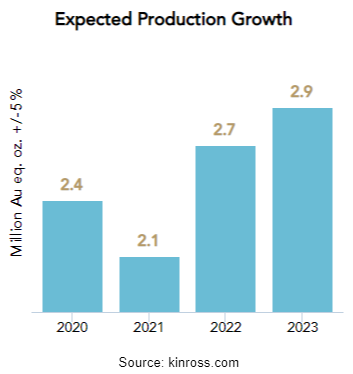
Turning the corner on capital allocation challenges
Some analysts have pointed to Kinross’ capital allocation challenges, including share dilution to finance expensive acquisitions in the post-2008 gold bull market, followed by impairment charges and underperforming assets.
Capital allocation concerns were echoed following the recent $1.42 billion acquisition of Great Bear Resources Ltd. The market punished Kinross in December of last year for what many felt was an expensive bid for Great Bear’s Dixie project, an exploration stage asset that had no resource estimate.
While it remains to be seen whether $1.42 billion was a good investment, other aspects of the capital allocation strategy (such as paying off debt and returning capital to shareholders) could be gauged in the nearer-term. Kinross repaid $500 million of senior debt in 2021 and maintains a low debt-to-equity ratio of 0.21. The company also returned $250 million to shareholders in 2021 through $150 million in dividends and $100 million in buybacks.
The longer-term success of Kinross’ capital allocation strategy will depend on their ability to maintain these trends which, in turn, would require strong sustained cash flows from production and gold prices. To appease the market on the expansion side of the strategy, the Dixie project would need a resource estimate of at least 7-8 million oz.
Russian operations and sanctions
About 20% of 2021 production came from the Kupol mine in Russia. The company issued a statement in response to the February 22 sanctions, maintaining that operations were unaffected. Whether this holds in light of developing events, remains to be seen.
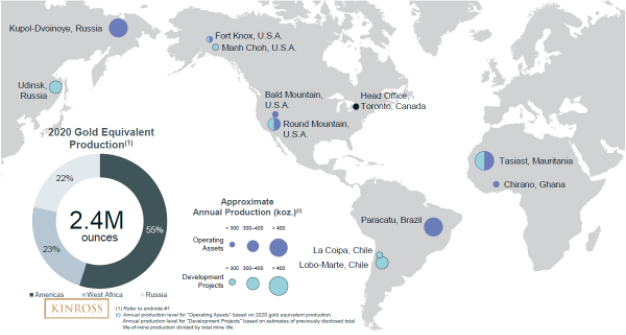
Source: kinross.com
In response to a question in the Q4 earnings call, CEO Paul Rollinson highlighted their 25 year operating success in Russia, as well as the fact that 98% of site employees are Russian and mine supplies are procured regionally. Even if supply chains were disrupted, the remote site is stocked to operate well into 2022.
Rollinson also pointed out that Kinross operations were not affected by sanctions after the 2014 Crimea crisis. In fact, the subsequent decline in the ruble enhanced margins. Moreover, it is expected that Kupol will account for a lower percentage of total production (13%) in 2022 as they transition to mining narrower veins.
Basis for improved equity performance
The silver lining of Kinross’ recent underperformance is a relatively cheap equity price with strong fundamentals. Their relatively favourable ESG rankings could also be a positive should institutional capital reenter the sector.
For 2022, investors will be looking for a return to forecasted production together with a resource estimate indicating Dixie was a good investment.
The above references an opinion and is for information purposes only. It is not intended to be investment advice. Seek a licensed professional for investment advice. The author is an insider or shareholder of one or more of the companies mentioned above.
If you would like to receive our free newsletter via email, simply enter your email address below & click subscribe.
CONNECT WITH US
Tweets
Tweet with hash tag #miningfeeds or @miningfeeds and your tweets will be displayed across this site.
MOST ACTIVE MINING STOCKS
Daily Gainers
 Lincoln Minerals Limited Lincoln Minerals Limited |
LML.AX | +125.00% |
      |
GCR.AX | +33.33% |
      |
CASA.V | +30.00% |
      |
AHN.AX | +22.22% |
      |
ADD.AX | +22.22% |
      |
AZM.V | +21.98% |
      |
NSE.V | +21.05% |
      |
DYG.V | +18.42% |
      |
AAZ.V | +18.18% |
      |
GLA.AX | +17.65% |

 Follow us on Twitter
Follow us on Twitter Become our facebook fan
Become our facebook fan








